Argentina Could Be a Superpower
The United States of Latin America
Encuentra este artículo en español debajo del inglés.
Argentina used to be rich:

Its capital, Buenos Aires, was “the Paris of South America”.
For decades, Argentina (which means “the country of silver”) was among the richest countries on Earth—richer than France, Germany, Japan, or Italy:
Millions of Europeans flocked there during its Belle Époque, dreaming of being “as rich as an Argentine”.
But then, this happened:
Not only did the Western world leave Argentina behind. Traditionally poorer countries like Chile and China are now richer! And Brazil is catching up!
How is this possible?
Because, unlike most countries I write about, Argentina is poor despite its amazing geography. With better management, it could become the United States of Latin America. Here’s why.
1. Size
The US is big, but Argentina isn’t too far behind—they’re the world’s 4th and 8th biggest country respectively. Argentina is much bigger than most people realize! It can easily contain France, Spain, Italy, Germany, and over 20 more European countries.1
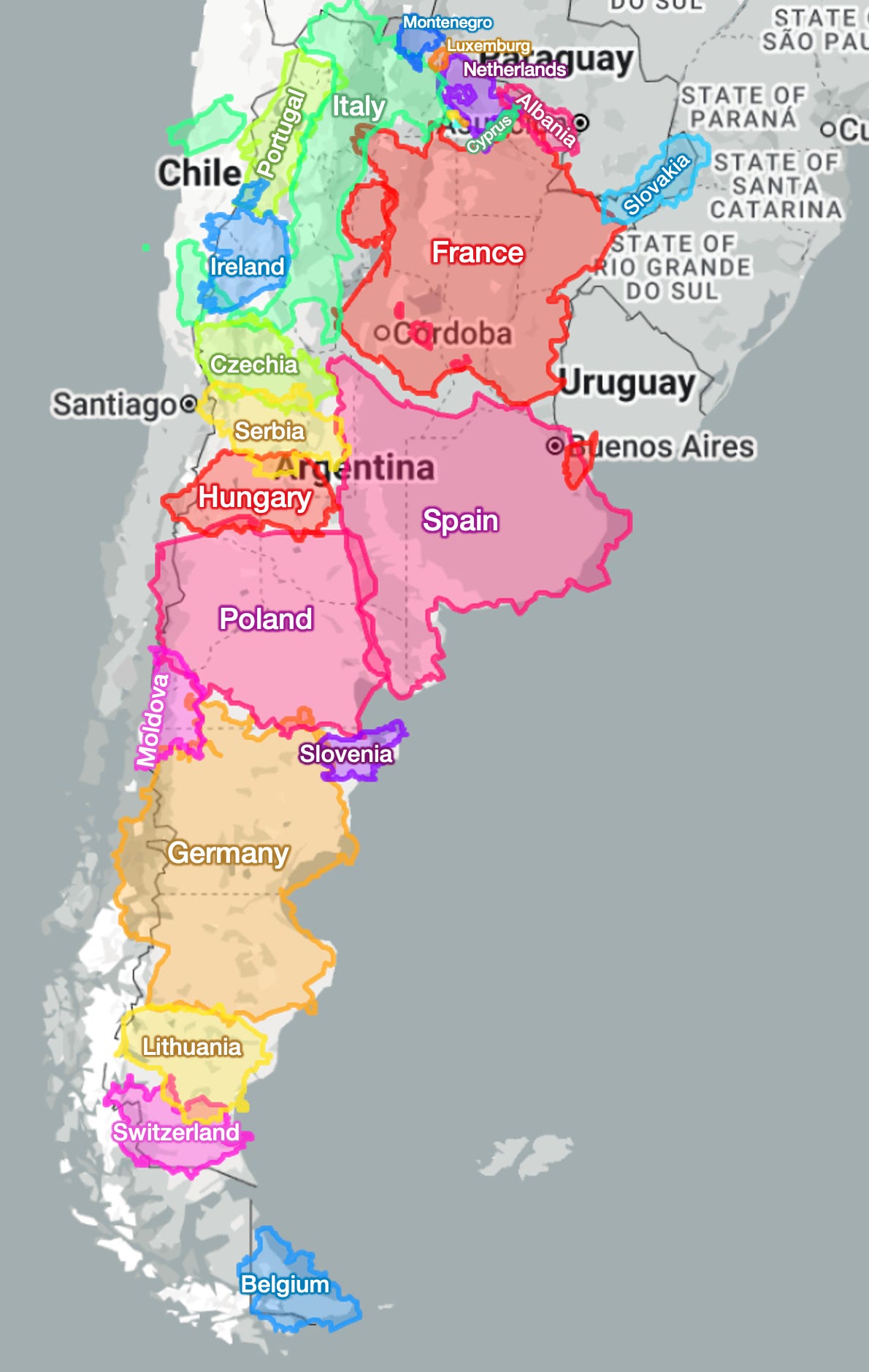
Argentina claims to be quite a bit bigger, though.
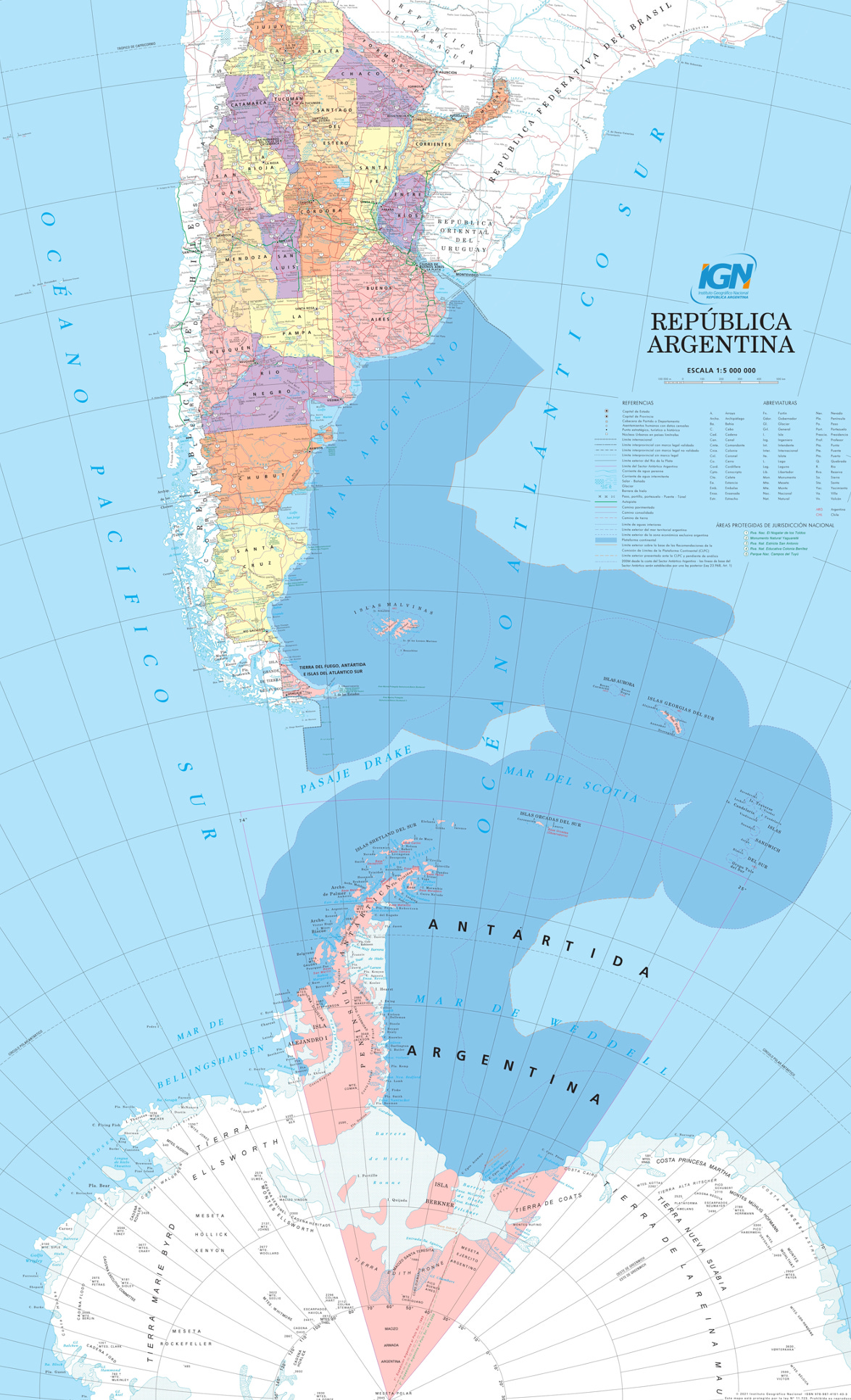
With such a great size comes massive resources and defensibility.
Defensibility
The defensibility of the US and Argentina are surprisingly similar.
One advantage that Argentina has is that it’s even more isolated than the US.
2. Oceans
The Pacific is too big for any threat trying to cross it, and Argentina’s western neighbors are even farther than the US’s (Japan is much closer to the US than New Zealand is to Argentina). And of course, Australia and New Zealand are more culturally aligned (and hence less threatening) than the US’s “neighbors”, Russia and China.
The Atlantic Ocean is not as big as the Pacific, but nevertheless much too vast for big powers to threaten Argentina from afar. Again, the US is close to the action (to Europe and Russia), while Argentina’s neighbors on the other side of the Atlantic are much poorer and weaker African countries. As a result, there have been very few naval battles on the coasts of Argentina.
3. Ice
Argentina has no neighbors to its south, and no threat can come from frozen Antarctica. Plus, the Antarctic Ocean is one of the coldest, windiest, most inhospitable oceans in the world. Argentina is safe there.
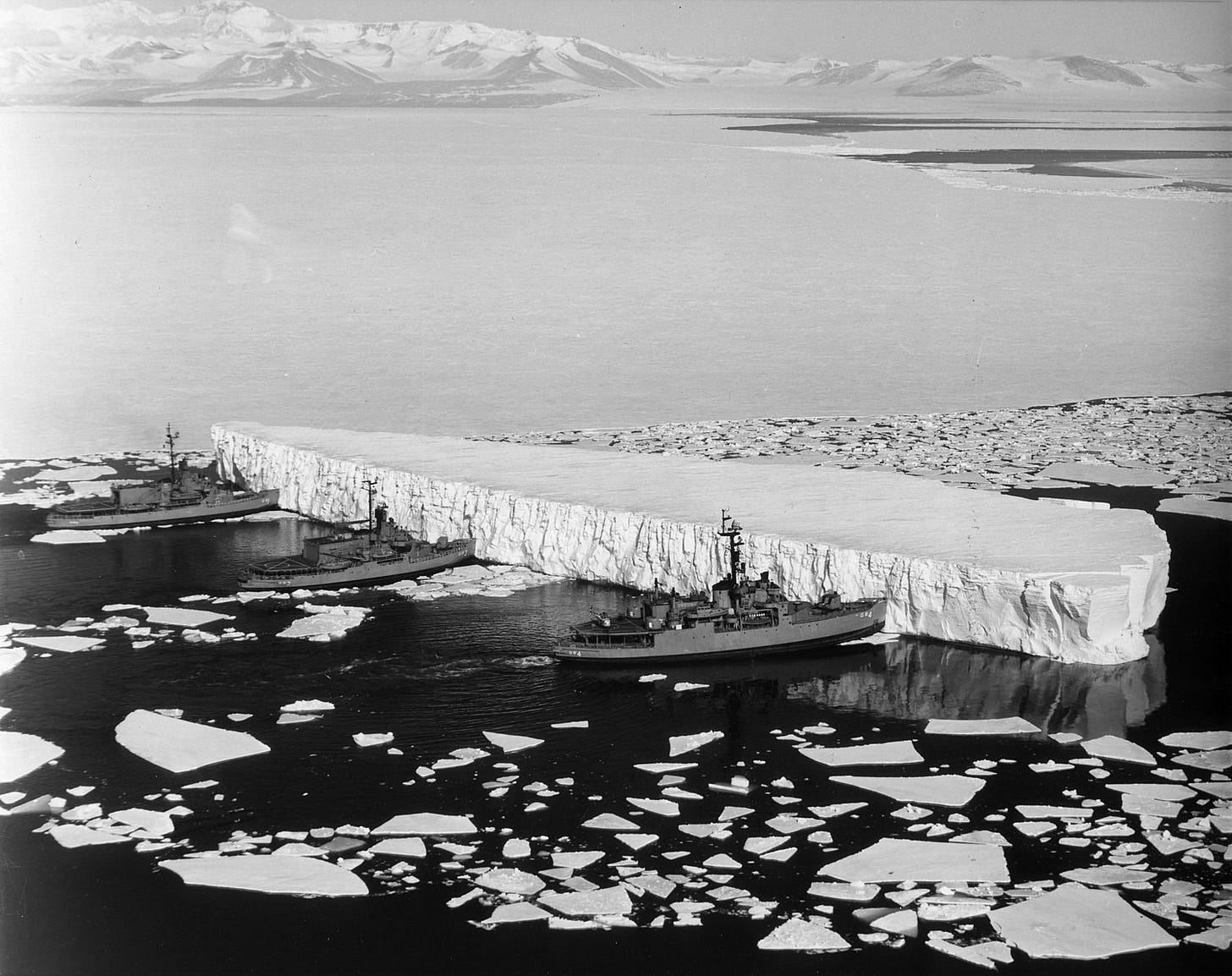
4. Mountains
To its west and northwest, one of the tallest mountain barriers on earth protects Argentina from Chile and Bolivia, the Andes:
That mountain range is pretty desertic, too. No army can pass to invade Argentina from there.
5. Weak neighbors
To the north, the border with Paraguay is quite flat, but if anyone should be afraid, it’s Paraguay, as Argentina’s economy dwarfs its own.
Paraguay already experienced this in the War of the Triple Alliance against Argentina, Brazil, and Uruguay, in which it lost over half of its population and nearly 40% of its territory.
Argentina only has one threat, but it’s significant.
Argentina’s Achilles Heel
Can you guess?
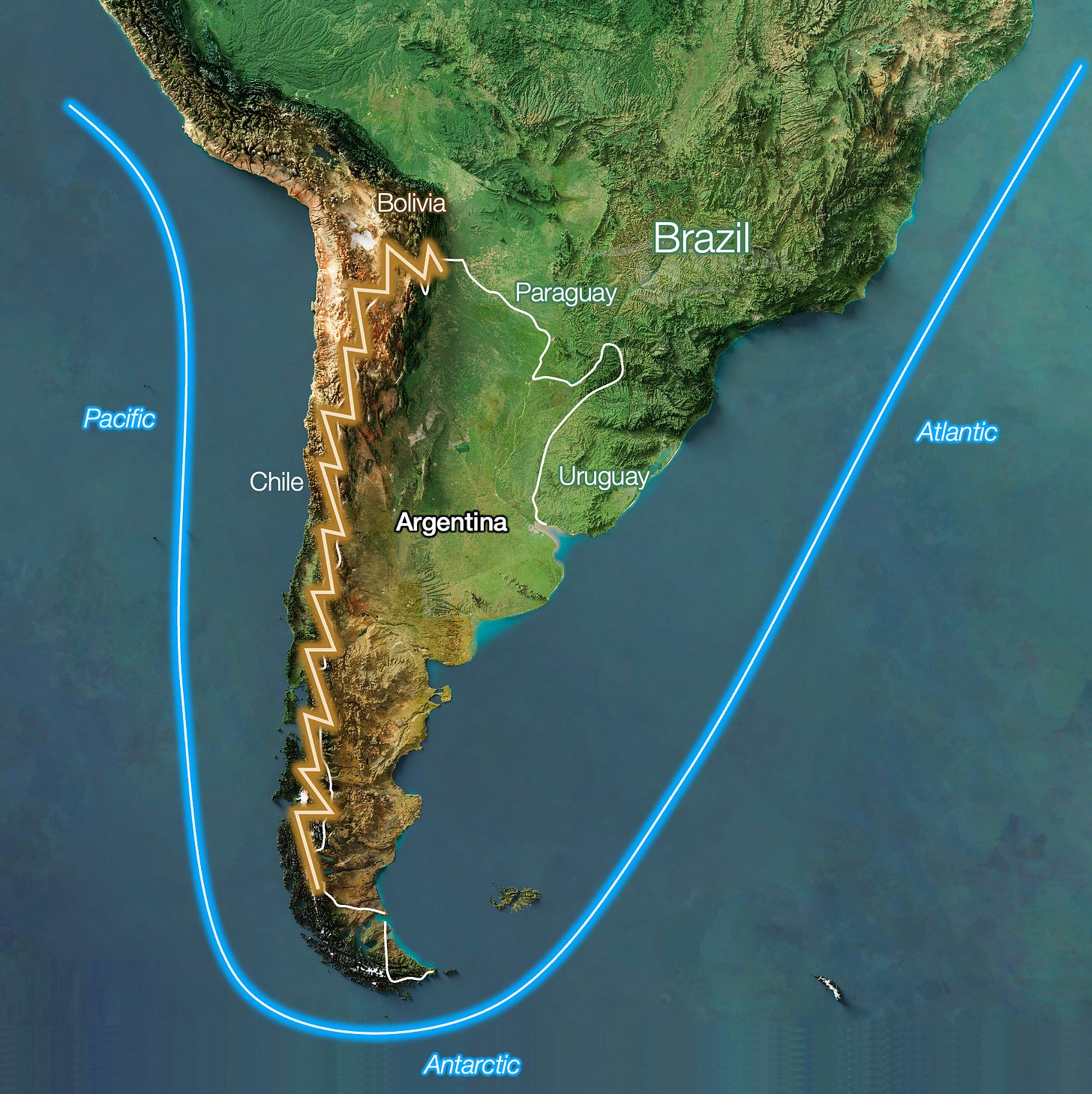
Brazil is much bigger than Argentina, in surface area (3x), population (4.5x), and economy (3.5x).
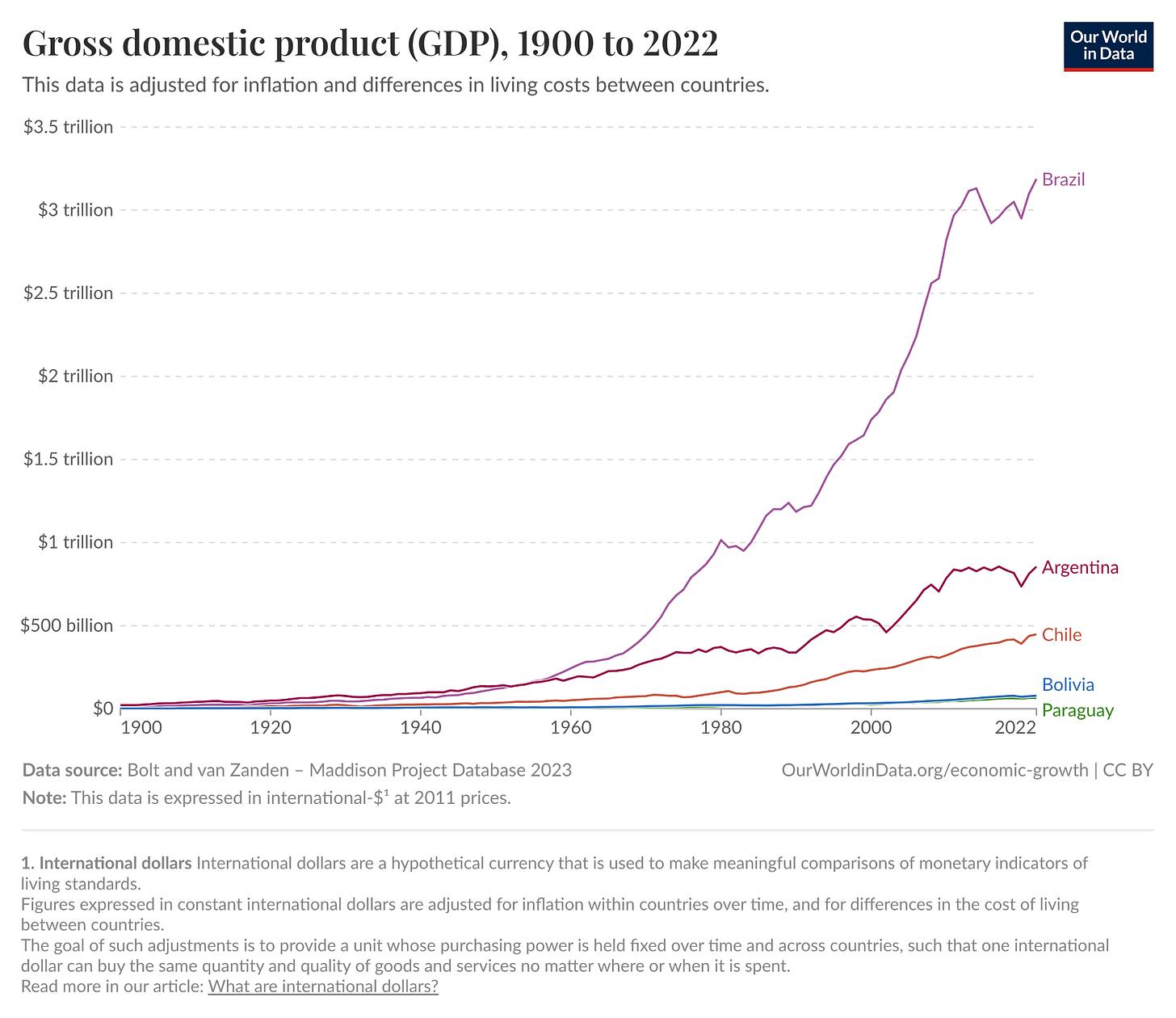
This means Argentina’s first (and nearly only) geostrategic priority is a good relationship with Brazil.
The Argentinian Mississippi
In Never Bet Against America, I highlighted one of the best sources of US power: The Mississippi River Basin.
Since the entire Mississippi river basin is quite flat, it doubles up as an amazing irrigation field for crops and the perfect highway to bring produce to world markets, as it’s the biggest network of natural navigable waterways in the world.
Well, Argentina is the same!
It has a huge flat plain in warm and temperate climates, which is ideal for growing lots of food.
It’s flanked by two mountain ranges that concentrate water into a navigable river basin that reaches the ocean and makes transportation dirt cheap.
And if you think it’s a coincidence, think again, for both lateral mountain ranges have the same origins in the US and Argentina! On the western side, we find the tall mountain ranges.
That’s because they’re young, the product of the ongoing subduction of oceanic plates (the Pacific plate is pushing Cocos and Nazca eastwards) under continental plates (the North and South American ones).
Meanwhile, to the east, the Appalachians, the Canadian Shield, the Brazilian Shield, and Africa used to be part of the same ancient continent!
And in between? Both North and South America had inland seaways in the past!
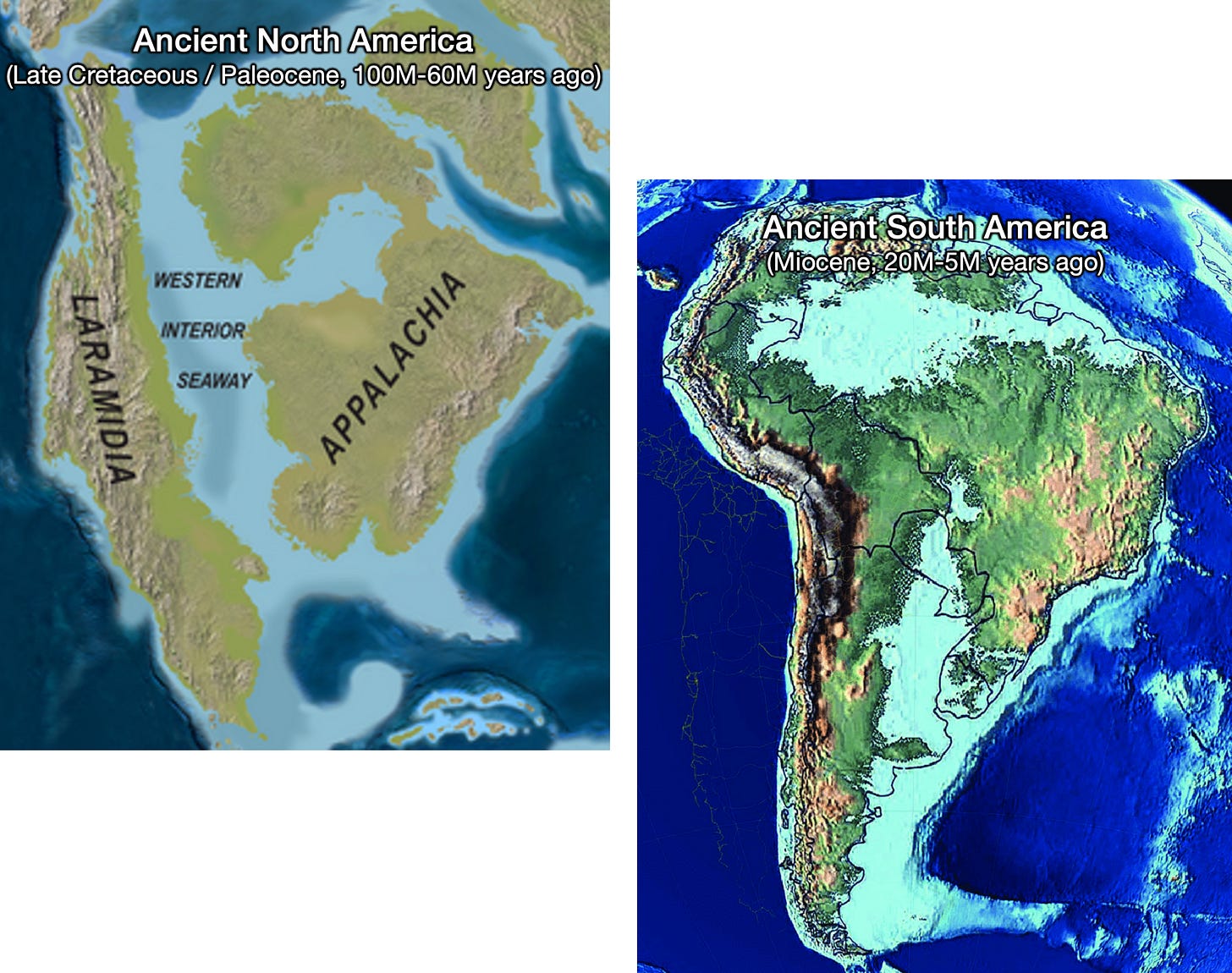
And this is why both areas are low-lying flat plains, with similar soil quality: They formed the same way! A sea formed in between mountain ranges, sediments accumulated, and after the sea receded, rivers and wind slowly deposited more sediments.
6. Amazing Farmland
Here are the resulting soils in North and South America:
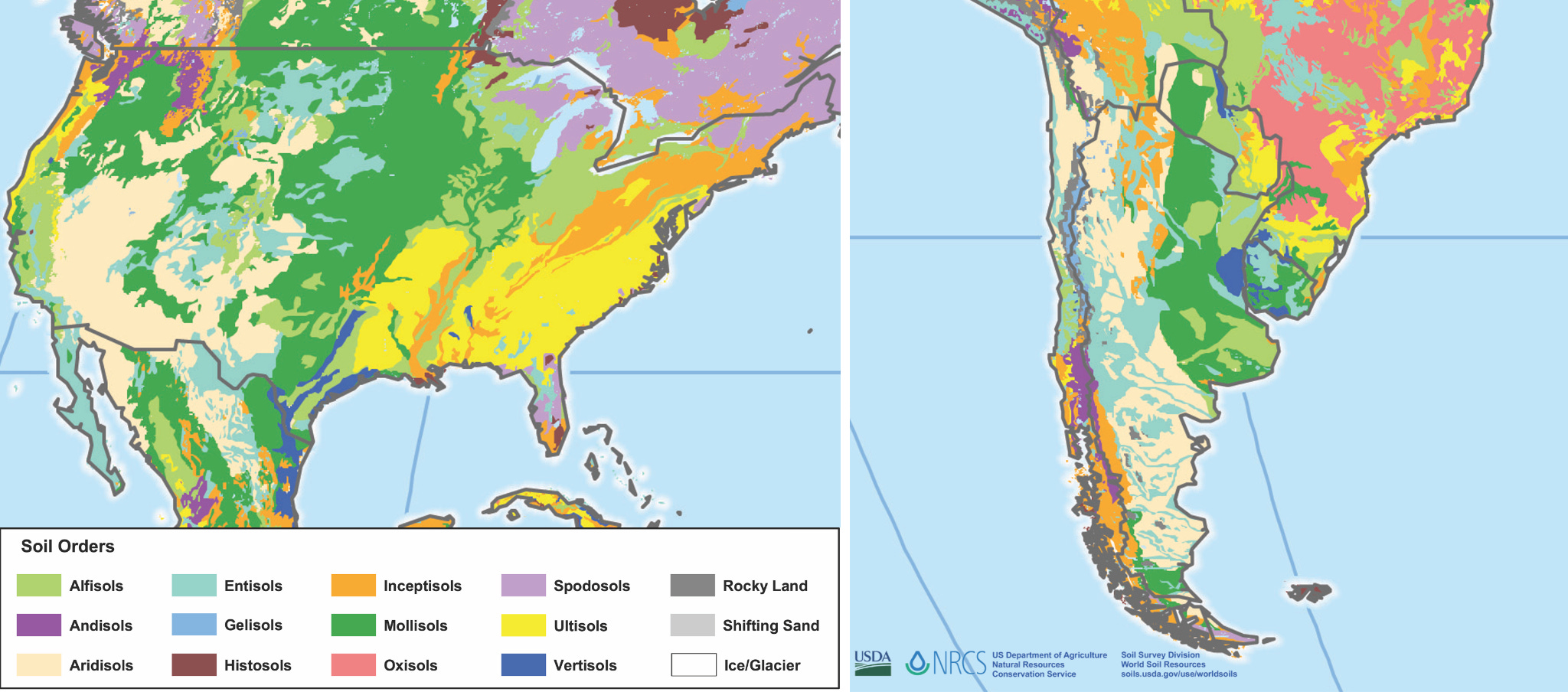
This is the result of these amazing soils:

Of course, for this type of agriculture, you need more than flat terrain full of sediments and great rivers. You need the right climate, including proper temperature and precipitation.
7. The Perfect Climate
Not only do the US and Argentina have a similar geography for the same geological reasons. They’re also at similar latitudes, just on opposite sides of the equator!
Let’s fold the map around the equator:
This is the key reason why the main climates of these countries are so similar:
Due to the rotation of the Earth, the prevailing winds around the globe look like this:
This makes the US West Coast, the Amazon, and southern Chile very wet. But these rains also affect the north of Argentina, feeding the Río de la Plata basin, and dropping tons of water on the eastern Andes:
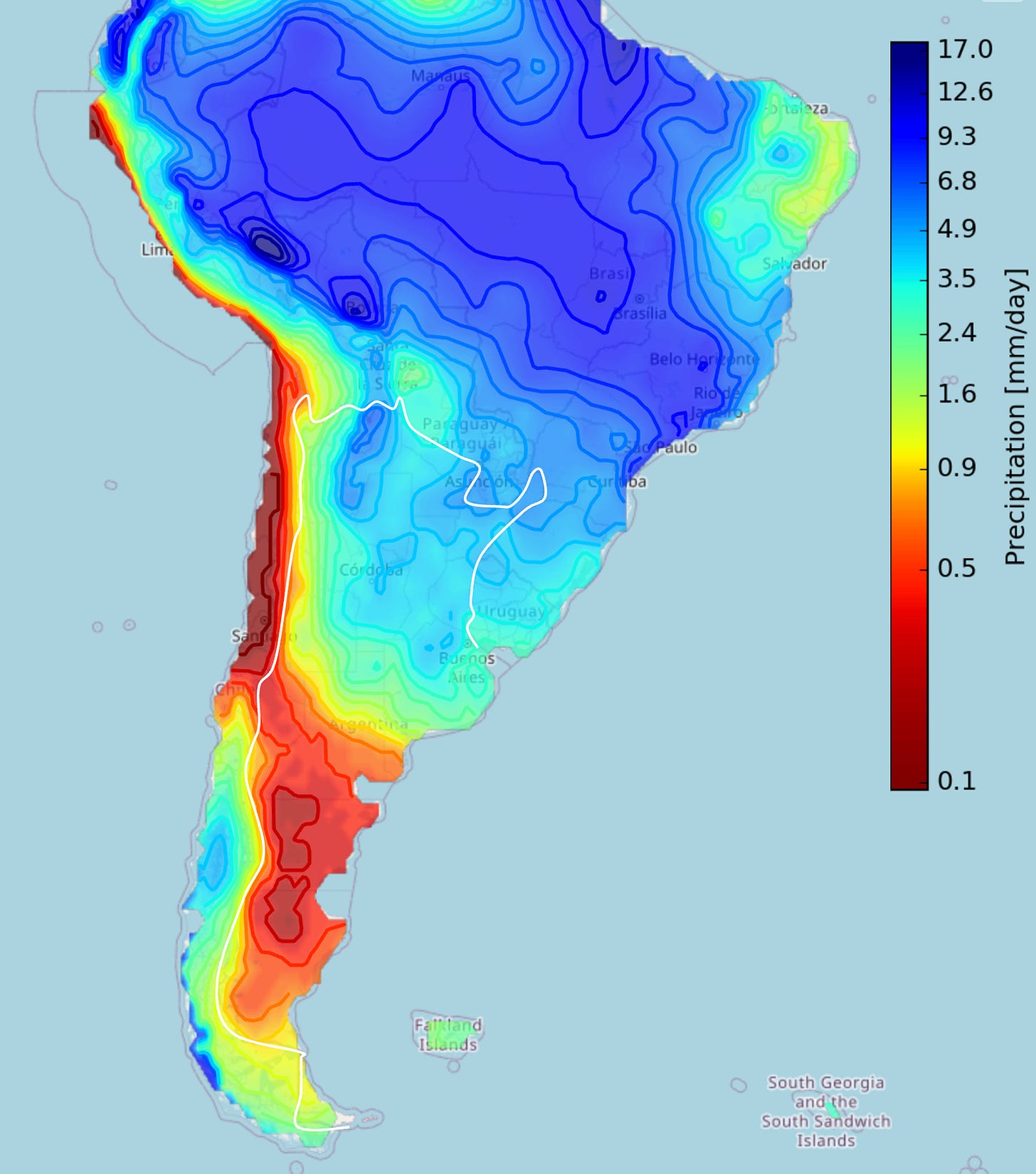
And that’s why northern Argentina gets a lot of rain (and is therefore much greener), while the south is drier and is browner, with more grasses.
The US has a sea to its south that affects the rains,2 so instead of a north-south difference, it has an east-west one. This determines the type of food it produces:
The equivalent for Argentina is agriculture in the north and ranching in the south:
And that’s why you get cowboys in both the US and Argentina—gauchos!
In other words, the US has the Great Plains, Argentina has the Pampas. And with their similar soils and climates, they can produce and export inordinate amounts of food.
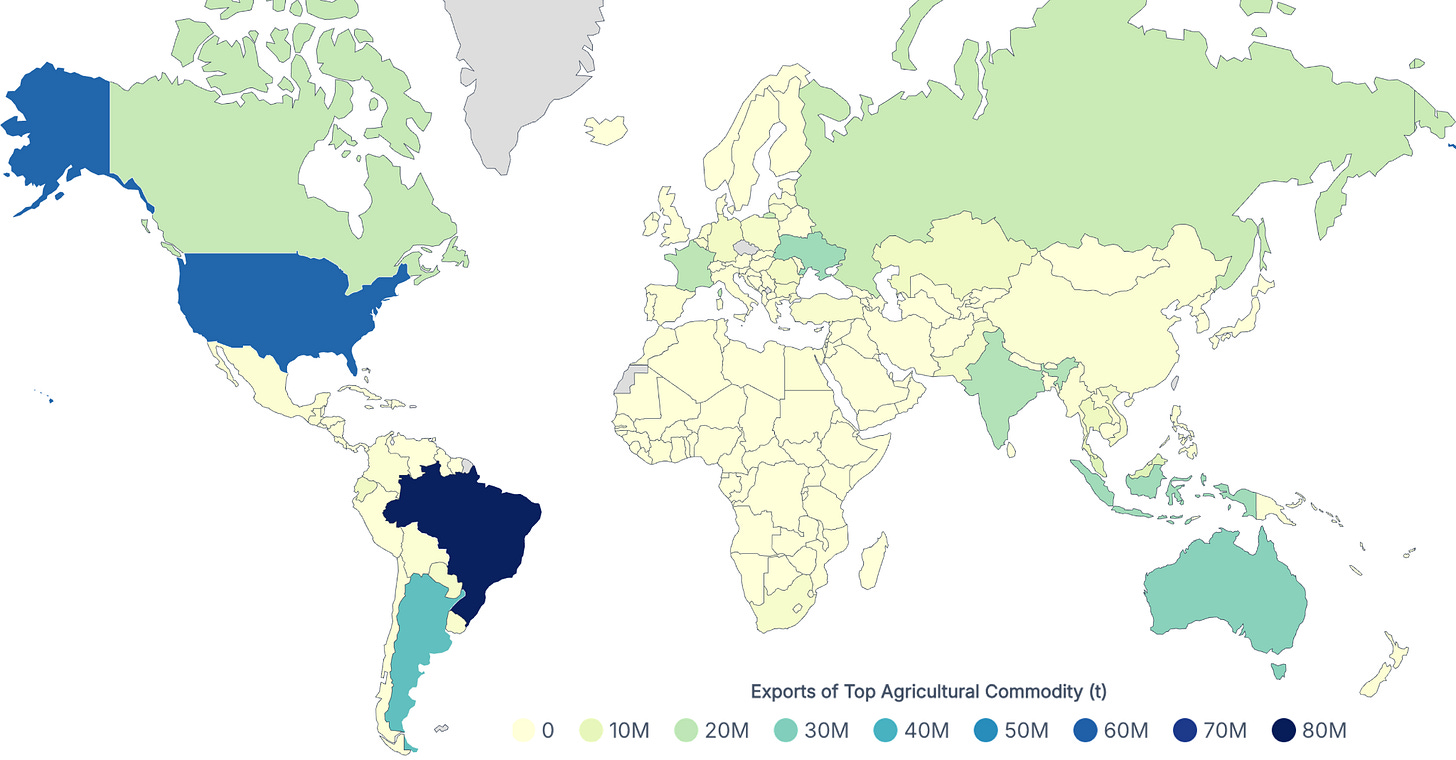
Compare Argentina’s farmland with the rest of South America’s!
8. Cheap Construction
Each dollar invested goes much further in Argentina than anywhere else in South America, because it’s much easier and cheaper to build on flat land. You don’t need to level the ground, build retaining walls, fill slopes, displace much soil, build deep, deal with uneven foundations, break hard stone, spend a lot to ship materials and machinery, risk landslides, or pay high insurance premiums to cover for natural risks.
9. The River Highway
As a reminder, water transportation is 10-30x cheaper than over land, and yet just halving transportation costs can increase trade by up to 16x! That means water transportation can make a region hundreds of times richer. US and Argentinian farmers can make much more money, accumulate more wealth, and invest more easily than those from other countries.
This is why it’s so important that the Río de la Plata system is so navigable:
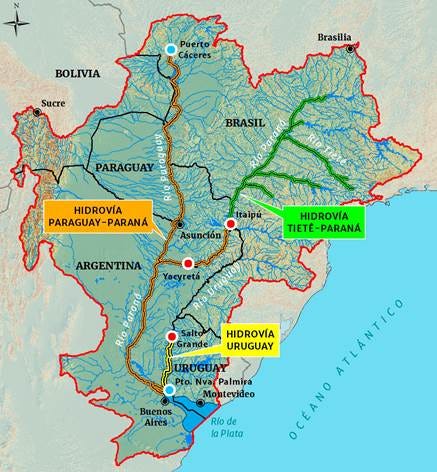
This is crucial in this area, which produces lots of agricultural and mining products that cost little but are heavy—therefore expensive to transport by road. Without this river system, it’s possible that none of these products could be successfully exported.
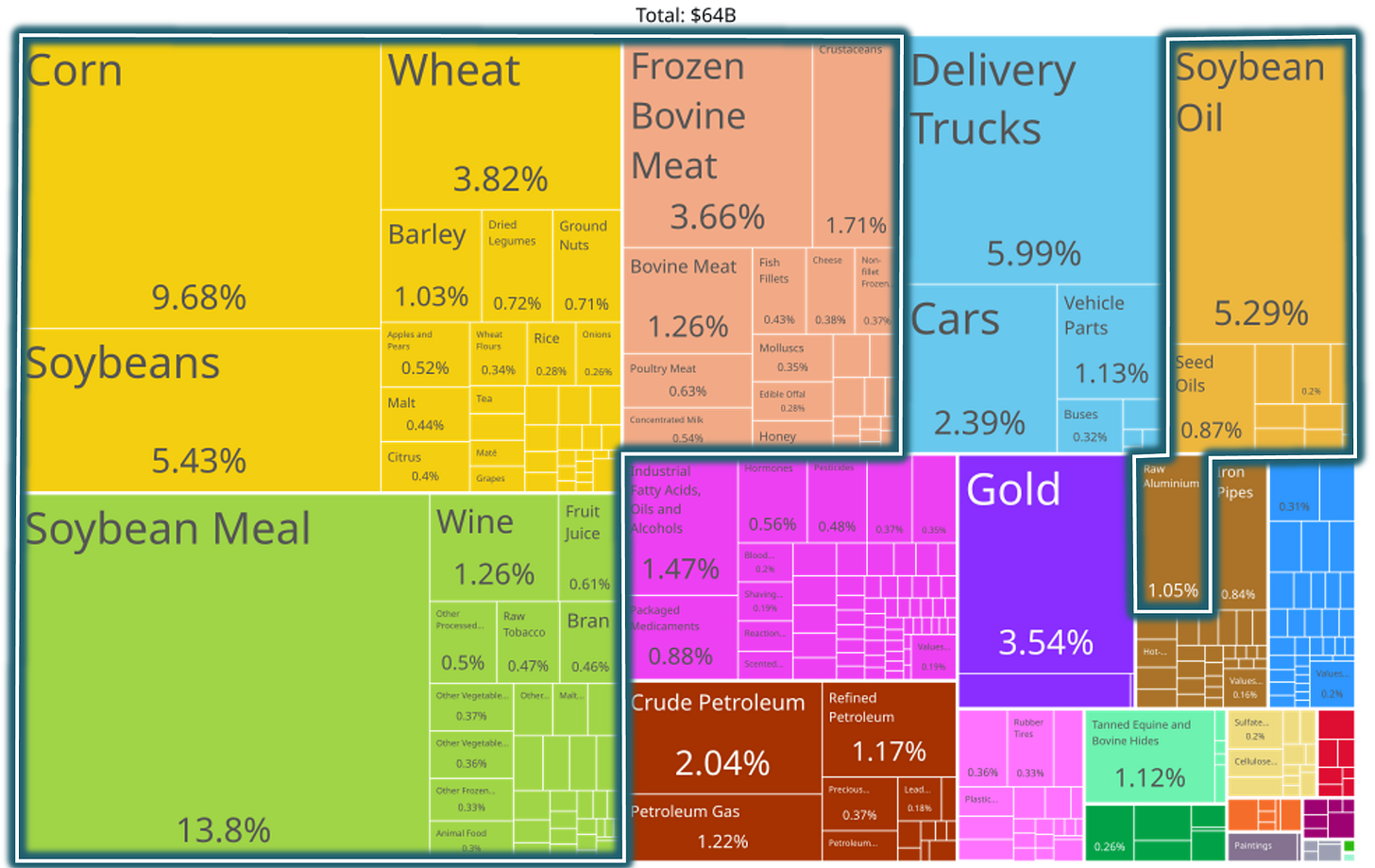
Compare this to Russia, the biggest country in the world with some of the best farmland. It should be the biggest exporter of food in the world. Instead, it sometimes runs out of food because it spoils due to bad weather and transportation!
10. Political Harmony
Argentina, Paraguay, Uruguay, and Brazil fought over their borders after the independence of Latin America in the first half of the 1800s. But after the War of the Triple Alliance, they were done. The countries haven’t gone to war with each other in over 150 years, and a key reason for this is the Río de la Plata system.
As we discussed in Never Bet Against America, the Mississippi is a cultural and political unit because local populations constantly trade with each other and their trading interests are the same. This was not the case on the East Coast of the US (as rivers flow from the mountains to the coasts), and isn’t the case in Europe either, which is why so many nations emerged there and they fought so many wars.
The Río de la Plata is the same, a single river system that promotes trade, cultural exchange, communication, and cooperation. It’s the second biggest interconnected navigable river waterway in the world after the Mississippi, and Argentina holds the key to the system: Buenos Aires.
11. Unbelievable Port
Look at the Río de la Plata:
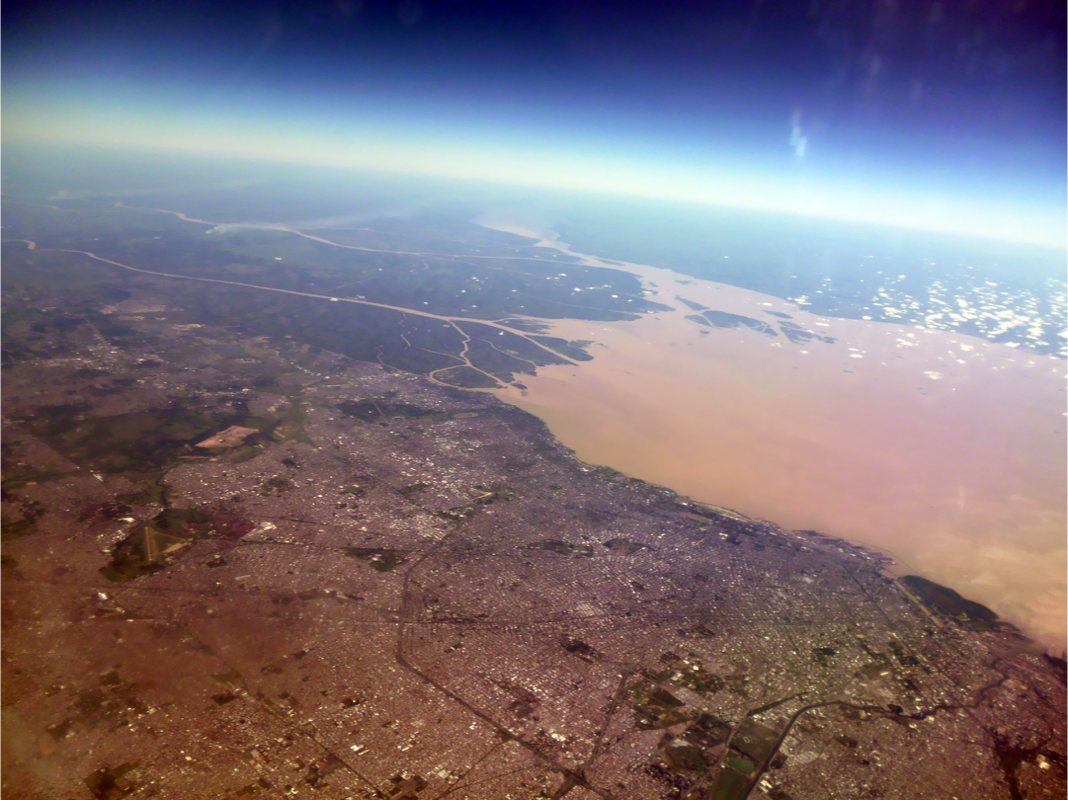
It is not a coincidence that Buenos Aires, Argentina’s capital, is found right where the Paraná and Uruguay rivers meet to form the Río de la Plata: It’s the perfect hub to trade all the products from the north of Argentina, Paraguay, southern Brazil, and Uruguay.
This gives Buenos Aires an incredible economic clout and lots of leverage on all its northern neighbors, who must go through Argentinian waters and the Buenos Aires port to trade with the world.
12. Mining Potential
Chile is one of the biggest exporters of minerals (copper, lithium, silver, iron), but Argentina is not. Yet they’re both on the same mountain range!
Chile has been a bit luckier here, because the rains on their side have created more erosion and exposed more ores, which are easy to transport to the nearby coast. Argentina needs more prospecting and infrastructure to bring trains, roads, and water to its mining regions. This is possible but it requires more investment.
Untapped Potential
With all these assets, Argentina could be a world superpower. But it’s not. What happened? We saw that Argentina’s GDP per capita is much lower than the US’s despite having a similar geography. But it’s not the only difference. Here is Argentina’s population density:
You can notice a few things:
See that huge spike? Buenos Aires concentrates a huge share of Argentina’s population: 38%!
The dark circle represents the Pampas, with the good climate we saw. But it has very few big cities. Look how it compares to the US’s Midwest.
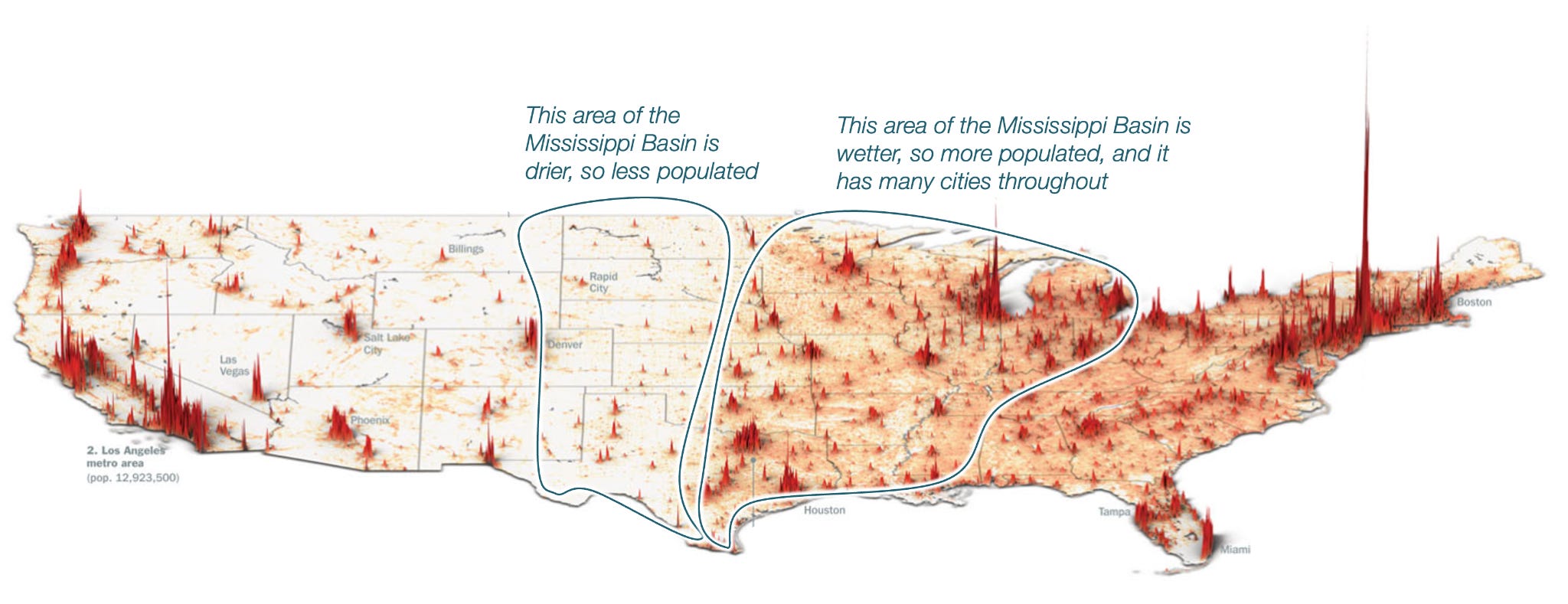
Outside of the Pampas, you can see population along the fall line of the Andes mountains
This is very typical of cities: People live on flatlands because it’s easier and cheaper, but stay close to mountains to benefit from their resources.
Outside of Buenos Aires and the Andes’ foothills, there is very little population, even in areas that have a similar climate in the Northern Hemisphere and are more populated there!
The US is not very densely populated: Germany hosts 240 people per km2, while the US only has 37 (6.5x less). Argentina is less populated still, at 16.8 people per km2, or 55% less than the US and 93% less than Germany! If it had the same population density as the US, it would be a sizable 94M strong. If it had Germany’s, it would have 680M!
Why so unpopulated despite ideal land?
Over the last 250 years, while immigrants were pouring into the US, Argentina was only growing as fast as Canada, which has a much worse climate.
What can we make of all of this?
Argentina’s Potential as a Superpower
Argentina is basically the US of the Southern Hemisphere:
Very similar defensibility, with oceans, mountains, and ice on three sides, and weak neighbors on the other
The huge exception is Argentina’s neighbor, Brazil.
Very similar land and climate, allowing for a world-class agriculture industry and cheap infrastructure.
A very similar navigable river basin in the heartland, helping reduce transportation costs, and creating wealth and political harmony, all controlled from Buenos Aires.
Huge, untapped mineral deposits.
Despite these striking advantages, Argentina has not been able to translate them into immigration and wealth. Geography is not destiny.
One way to put it: Geography is the hardware, our institutions are the software. When both work well, a country is unstoppable. With bad hardware but intelligent software, a country can go far. But it’s easy to waste good hardware with very bad software. This is what Argentina has done. Another way to put it: Geography is the chessboard: How you play on it determines your success, and Argentina hasn’t played very well. Why? This is what we will explore in the next article. Subscribe to read it!
Versión en español:
Argentina Podría Ser una Superpotencia
Argentina era rica:

Su capital, Buenos Aires, era “el París de Suramérica”.
Durante décadas, Argentina (“país de la plata”) fue uno de los países más ricos del mundo—más que Francia, Alemania, Japón o Italia.
Millones de europeos emigraron allí durante su Belle Époque, soñando con “ser tan ricos como un argentino”.
Pero ocurrió esto:
Argentina se ha quedado atrás en comparación con el resto del mundo occidental. Países tradicionalmente más pobres, como Chile o China, son hoy más ricos. ¡Y Brasil la está alcanzando!
¿Cómo es posible?
Porque, a diferencia de la mayoría de países de los que suelo escribir, Argentina es pobre a pesar de su geografía extraordinaria. Con una mejor gestión, podría convertirse en los Estados Unidos de América del Sur.
He aquí el porqué.
1. Tamaño
Estados Unidos es grande, pero Argentina no se queda tan atrás: son, respectivamente, el cuarto y el octavo país más extensos del mundo. Argentina es mucho más grande de lo que la mayoría se imagina. Podría contener sin problema a Francia, España, Italia, Alemania y más de veinte países europeos adicionales.

Argentina afirma ser aún más grande.

Este tamaño gigantesco le otorga recursos inmensos e impregnabilidad.
La Argentina Impregnable
La capacidad de defensa de Estados Unidos y Argentina es sorprendentemente similar.
Una ventaja argentina es que se encuentra aún más aislada del resto del mundo.
2. Océanos
El Pacífico es demasiado vasto para que vecinos del otro lado puedan amenazar a Argentina. Además, esos vecinos están incluso más lejos que los de EE. UU. (Japón está mucho más cerca de Estados Unidos que Nueva Zelanda de Argentina).
Y Australia y Nueva Zelanda están más alineadas culturalmente —y, por tanto, son menos amenazantes— que los “vecinos” de Estados Unidos, Rusia y China.
El Atlántico no es tan inmenso como el Pacífico, pero sigue siendo demasiado ancho para que potencias lejanas puedan proyectar fuerza hacia Argentina.
De nuevo, Estados Unidos está más cerca de los focos de tensión (Europa y Rusia), mientras que los países al otro lado del Atlántico de Argentina son naciones africanas más pobres y débiles. Resultado: muy pocas batallas navales se han librado en las costas argentinas.
3. Hielo
Argentina no tiene vecinos al sur, y ninguna amenaza puede llegar desde la helada Antártida. Además, el océano Antártico es uno de los más fríos, ventosos e inhóspitos del planeta. Por allí, Argentina está completamente segura.

4. Montañas
Al oeste y noroeste, una de las barreras montañosas más altas del mundo protege a Argentina de Chile y Bolivia: los Andes.
Esa cordillera, además, es bastante desértica. Ningún ejército puede atravesarla para invadir el país.
5. Vecinos débiles
Al norte, la frontera con Paraguay es bastante llana, pero si alguien debe tener miedo, es Paraguay: la economía argentina supera con creces a la suya.
Paraguay ya lo experimentó durante la Guerra de la Triple Alianza contra Argentina, Brasil y Uruguay, en la cual perdió más de la mitad de su población y cerca del 40% de su territorio.
Argentina solo tiene una amenaza, pero es significativa.
El talón de Aquiles de Argentina
¿Puedes adivinar cuál?

Brasil es mucho más grande que Argentina: tres veces en superficie, 4,5 veces en población y 3,5 veces en economía.

Esto significa que la primera —y casi única— prioridad geoestratégica de Argentina es mantener una buena relación con Brasil.
El Misisipi argentino
En Never Bet Against America, señalé una de las mayores fuentes del poder estadounidense: la cuenca del río Misisipi.
Como toda esa cuenca es bastante llana, sirve tanto como un excelente sistema de riego agrícola como una autopista natural para transportar productos a los mercados mundiales, ya que es la red de vías navegables naturales más grande del planeta.
Argentina es igual!
Tiene una vasta llanura cálida y templada, ideal para producir alimentos en cantidad.
Está flanqueada por dos cordilleras que concentran el agua en una cuenca fluvial navegable que desemboca en el océano, haciendo que el transporte sea baratísimo.
¿Casualidad? Qué va. Ambas cadenas montañosas laterales tienen los mismos orígenes en Estados Unidos y Argentina. En el lado occidental se encuentran las cordilleras altas:
Estas montañas son tan altas porque son jóvenes, producto de la subducción actual de las placas oceánicas (la placa del Pacífico empuja las de Cocos y Nazca hacia el este) bajo las placas continentales (la norteamericana y la suramericana).
Mientras tanto, al este, los Apalaches, el Escudo Canadiense, el Escudo Brasileño y África formaban parte del mismo antiguo continente.
?Y entre ambas cordilleras? ¡Tanto Norteamérica como Suramérica tuvieron mares interiores en el pasado!

Y esta es la razón por la que ambas zonas son llanuras bajas y planas, con suelos de calidad similar: se formaron del mismo modo! Un mar se formó entre las montañas, se acumularon sedimentos, y cuando el mar retrocedió, los ríos y el viento siguieron depositando más.
6. Tierras de cultivo extraordinarias
Éste es el resultado en la tierra de América del Norte y del Sur:

Éste es el resultado de esos suelos excepcionales:

Por supuesto, para este tipo de agricultura no basta con un terreno llano lleno de sedimentos y grandes ríos. Hace falta también el clima adecuado: temperatura y precipitaciones en el punto justo.
7. El clima perfecto
Estados Unidos y Argentina no sólo tienen geografías parecidas por razones geológicas. También están en latitudes similares, solo que a lados opuestos del ecuador!
Doblemos el mapa alrededor del ecuador:
Esta es la clave de por qué los climas principales de ambos países son tan parecidos:
Debido a la rotación de la Tierra, los vientos dominantes del planeta son así:
Esto hace que la costa oeste de Estados Unidos, la Amazonia y el sur de Chile sean muy húmedos. Pero esas lluvias también afectan al norte de Argentina, alimentando la cuenca del Río de la Plata y dejando enormes cantidades de agua sobre los Andes orientales.

Y por eso el norte de Argentina recibe mucha lluvia (y es, por tanto, más verde), mientras el sur es más seco y más pardo, con más pastos.
Estados Unidos tiene un mar al sur que influye en las lluvias, lo que cambia la predominancia pluvial norte-sur por este-oeste. Esto determina el tipo de alimentos que produce.
El equivalente argentino es la agricultura en el norte y la ganadería en el sur.
Y por eso hay cowboys en Estados Unidos y gauchos en Argentina!
En otras palabras: Estados Unidos tiene las Grandes Llanuras, Argentina tiene las Pampas. Y con tierras y climas tan parecidos, ambos pueden producir y exportar cantidades desmesuradas de alimentos.

Compara la superficie agrícola de Argentina con la del resto de Suramérica:
8. Construcción barata
Cada dólar invertido rinde mucho más en Argentina que en cualquier otro lugar de Suramérica, porque es mucho más fácil y barato construir en terreno plano: no es necesario nivelar el suelo, levantar muros de contención, rellenar pendientes, mover grandes volúmenes de tierra, excavar profundamente, lidiar con cimientos irregulares, romper piedra dura, gastar demasiado en transporte de materiales y maquinaria, asumir riesgos de deslizamientos, ni pagar primas de seguro elevadas para cubrir riesgos naturales.
9. La autopista fluvial
Recuerda que el transporte por agua es entre 10 y 30 veces más barato que el terrestre, y que reducir a la mitad los costos de transporte puede multiplicar el comercio hasta 16 veces! Si combinas estos efectos te das cuenta de que un buen transporte fluvial puede hacer que una región sea cientos de veces más rica. Los agricultores estadounidenses y argentinos pueden ganar mucho más dinero, acumular más capital e invertir con mayor facilidad que los de otros países.
Por eso es tan importante que el sistema del Río de la Plata sea tan navegable:

Esto es crucial en esta región, que produce muchos bienes agrícolas y mineros de bajo valor unitario pero muy pesados, por lo tanto caros de transportar por carretera.
Sin este sistema fluvial, es posible que ninguno de estos productos pudiera exportarse de forma rentable!

Compara con Rusia, el país más grande del mundo y con algunas de las mejores tierras agrícolas. Debería ser el mayor exportador de alimentos del planeta. En cambio, a veces se queda sin ellos, porque se echan a perder por las malas comunicaciones del país
10. Armonía política
Argentina, Paraguay, Uruguay y Brasil disputaron sus fronteras tras las independencias latinoamericanas en la primera mitad del siglo XIX. Pero después de la Guerra de la Triple Alianza, no se han vuelto a enfrentar en más de 150 años, y una razón clave de esa paz es el sistema del Río de la Plata.
Como vimos en Never Bet Against America, el Misisipi constituye una unidad cultural y política porque las poblaciones locales comercian constantemente entre sí y comparten los mismos intereses económicos. No ocurría lo mismo en la costa este de Estados Unidos (donde los ríos fluyen de las montañas al mar), ni ocurre en Europa, motivo por el cual allí surgieron tantas naciones y tantas guerras.
El Río de la Plata cumple el mismo papel: es un único sistema fluvial que favorece el comercio, el intercambio cultural, la comunicación y la cooperación. Es la segunda red navegable interconectada más grande del mundo después del Misisipi, y Argentina posee la clave del sistema: Buenos Aires.
11. Puerto Increíble
Mira el Río de la Plata:

No es casualidad que la capital argentina esté justo donde el Paraná y el Uruguay se unen para formar el Río de la Plata: es el centro perfecto para comerciar todos los productos del norte de Argentina, Paraguay, el sur de Brasil y Uruguay.
Esto le otorga a Buenos Aires un peso económico enorme y una gran capacidad de influencia sobre todos sus vecinos del norte, que deben pasar por aguas argentinas y por su puerto para comerciar con el mundo.
12. Potencial minero
Chile es uno de los mayores exportadores del mundo de minerales (cobre, litio, plata, hierro), pero Argentina no. Y, sin embargo, ambos países comparten la misma cordillera!
Chile ha tenido algo más de suerte en este aspecto, porque las lluvias de su lado han generado más erosión y expuesto más vetas minerales, que además están cerca de la costa y son fáciles de transportar. Argentina, en cambio, necesita más prospección e infraestructura para llevar trenes, carreteras y agua a sus regiones mineras.
Es factible, pero requiere más inversión.
Potencial desaprovechado
Con todos estos recursos, Argentina podría ser una superpotencia mundial.
Pero no lo es. ¿Qué pasó?
Vimos que el PIB per cápita de Argentina es mucho más bajo que el de Estados Unidos, pese a tener una geografía similar. Pero no es la única diferencia. Observa la densidad de población argentina:
Hay varias cosas que saltan a la vista.
Ese enorme pico representa Buenos Aires, que concentra una parte desproporcionada de la población: 38%!
El círculo oscuro marca las Pampas, con el buen clima que vimos antes.
Pero allí hay muy pocas ciudades grandes. Compáralo con el Midwest estadounidense.

Fuera de las Pampas, se nota población a lo largo de la línea de contacto con los Andes.
Esto es muy típico: la gente vive en las llanuras —porque es más fácil y barato—, pero cerca de las montañas, para aprovechar sus recursos.
Fuera de Buenos Aires y del pie de los Andes, hay muy poca población, incluso en zonas con climas equivalentes a otros lugares del hemisferio norte que sí están mucho más poblados.
Estados Unidos no es particularmente denso: Alemania tiene 240 habitantes por km², mientras que EE. UU. solo 37 (6,5 veces menos). Argentina está aún menos poblada, con 16,8 habitantes por km², es decir, 55% menos que Estados Unidos y 93% menos que Alemania! Si tuviera la misma densidad que Estados Unidos, su población sería de unos 94 millones. Con la densidad de Alemania, alcanzaría los 680 millones!
¿Por qué están estas tierras ideales tan despobladas?
Durante los últimos 250 años, mientras los inmigrantes inundaban Estados Unidos, Argentina crecía al ritmo de Canadá, que tiene un clima mucho más duro.
¿Qué podemos concluir de todo esto?
El potencial de Argentina como superpotencia
Argentina es, en esencia, el equivalente de Estados Unidos en el hemisferio sur:
Defensibilidad muy parecida, con océanos, montañas y hielo en tres flancos, y vecinos débiles en el restante.
La gran excepción es su vecino, Brasil.
Tierras y clima muy similares, que permiten una agricultura de clase mundial y una infraestructura barata.
Una cuenca fluvial navegable en el corazón del país, que reduce costes de transporte, genera riqueza y estabilidad política, y está controlada desde Buenos Aires.
Enormes yacimientos minerales aún sin explotar.
A pesar de todas estas ventajas impresionantes, Argentina no ha logrado transformarlas en inmigración ni en prosperidad. La geografía no es destino.
La geografía es el hardware; las instituciones son el software. Cuando ambos funcionan bien, un país es imparable. Con mal hardware pero buen software, también puede avanzar mucho. Pero es fácil desperdiciar un gran hardware con un software pésimo. Eso es lo que ha hecho Argentina.
Otra forma de decirlo: la geografía es como un tablero de ajedrez que determina el juego. Cómo se juega en él determina el resultado.
Y Argentina no ha jugado bien.
¿Por qué?
Eso es lo que exploraremos en el próximo artículo.
I played around to see how many European countries I could fit in Argentina, comparing its landmass of ~2.8M km2 to the European countries ranked from smallest to largest. I took this list and excluded Akrotiri, Dhekelia, South Ossetia, Abkhazia, Transnistria, European Turkey and European Kazakhstan.
To be equivalent, Argentina would need a sea to its north, since it’s on the other side of the equator.



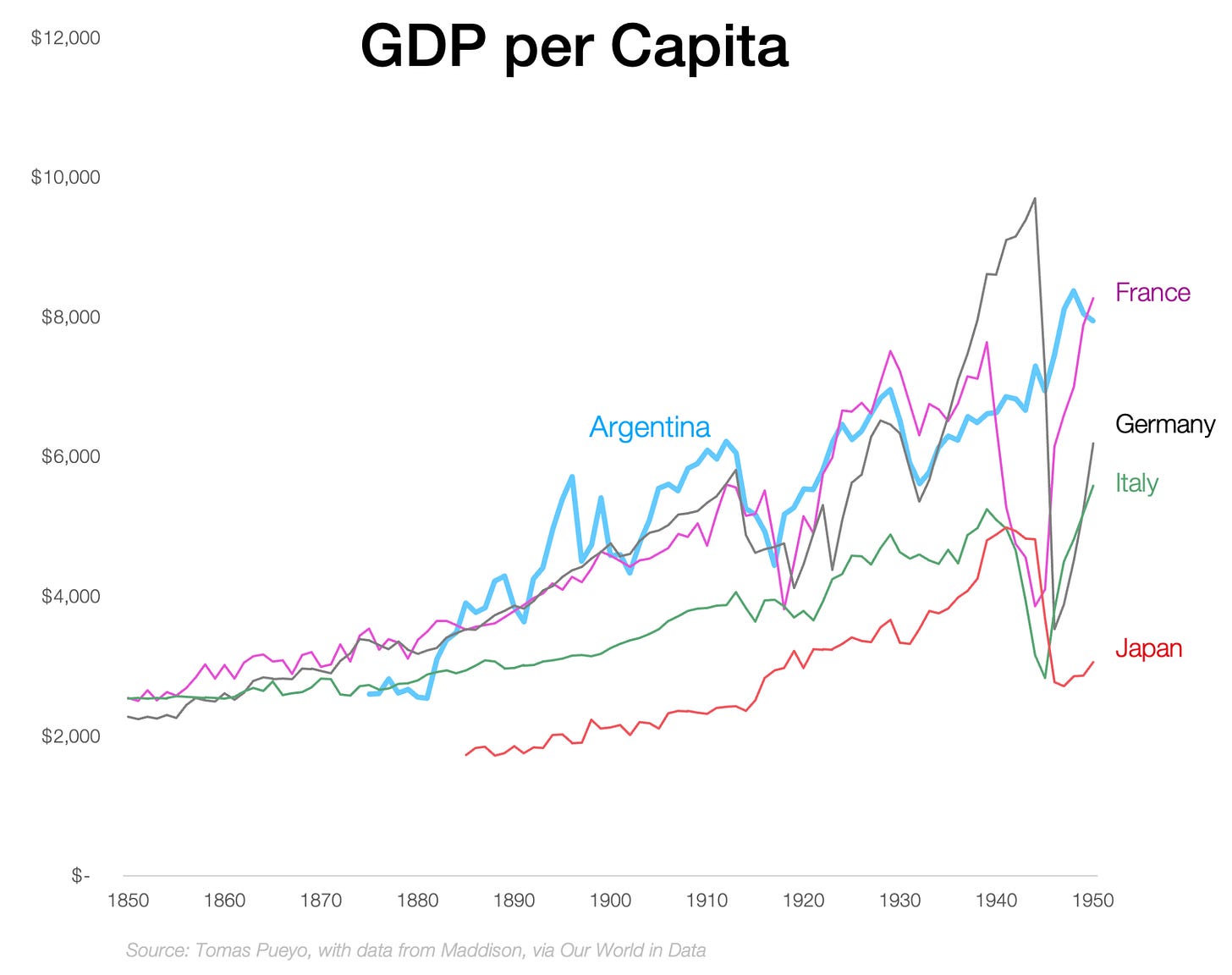

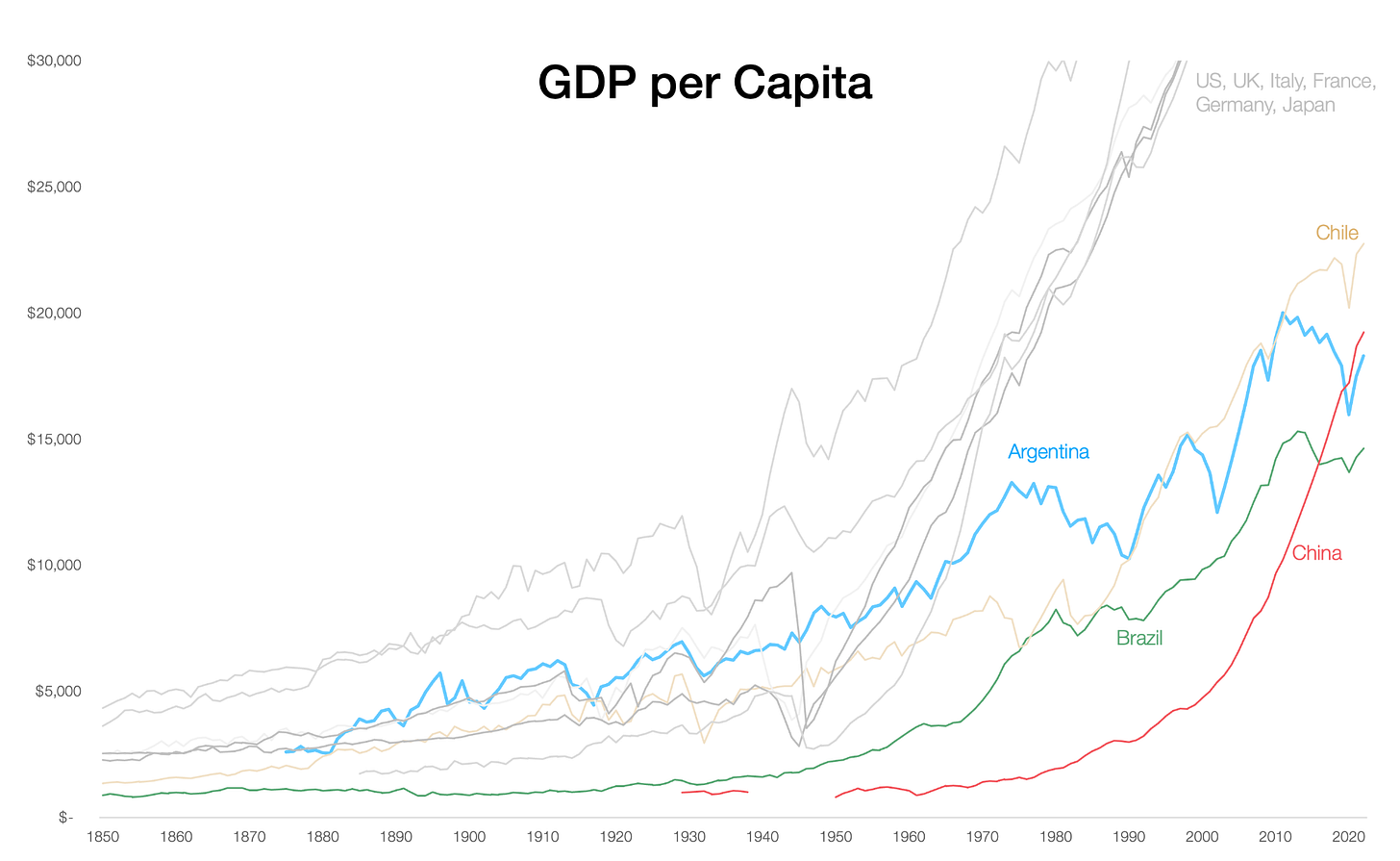
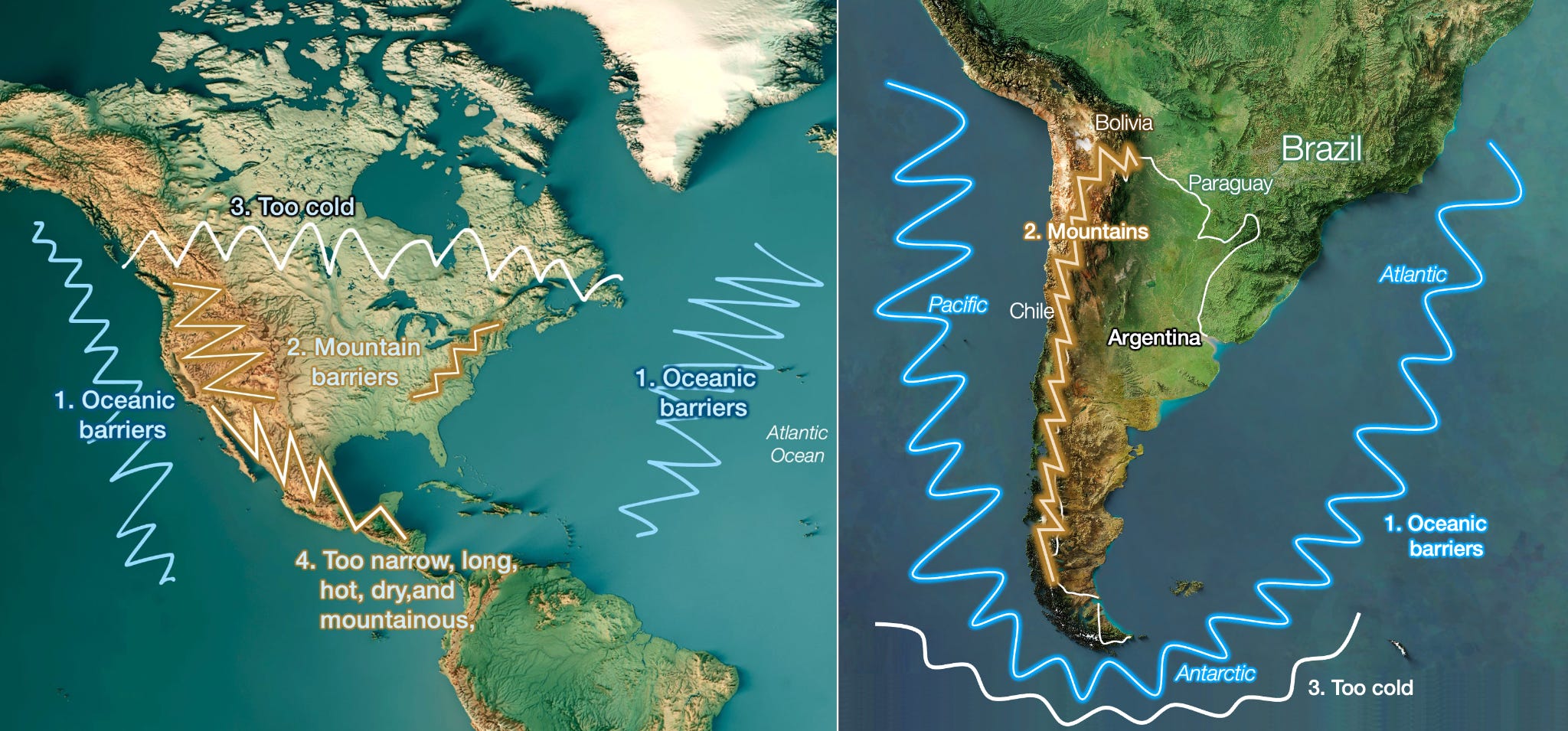
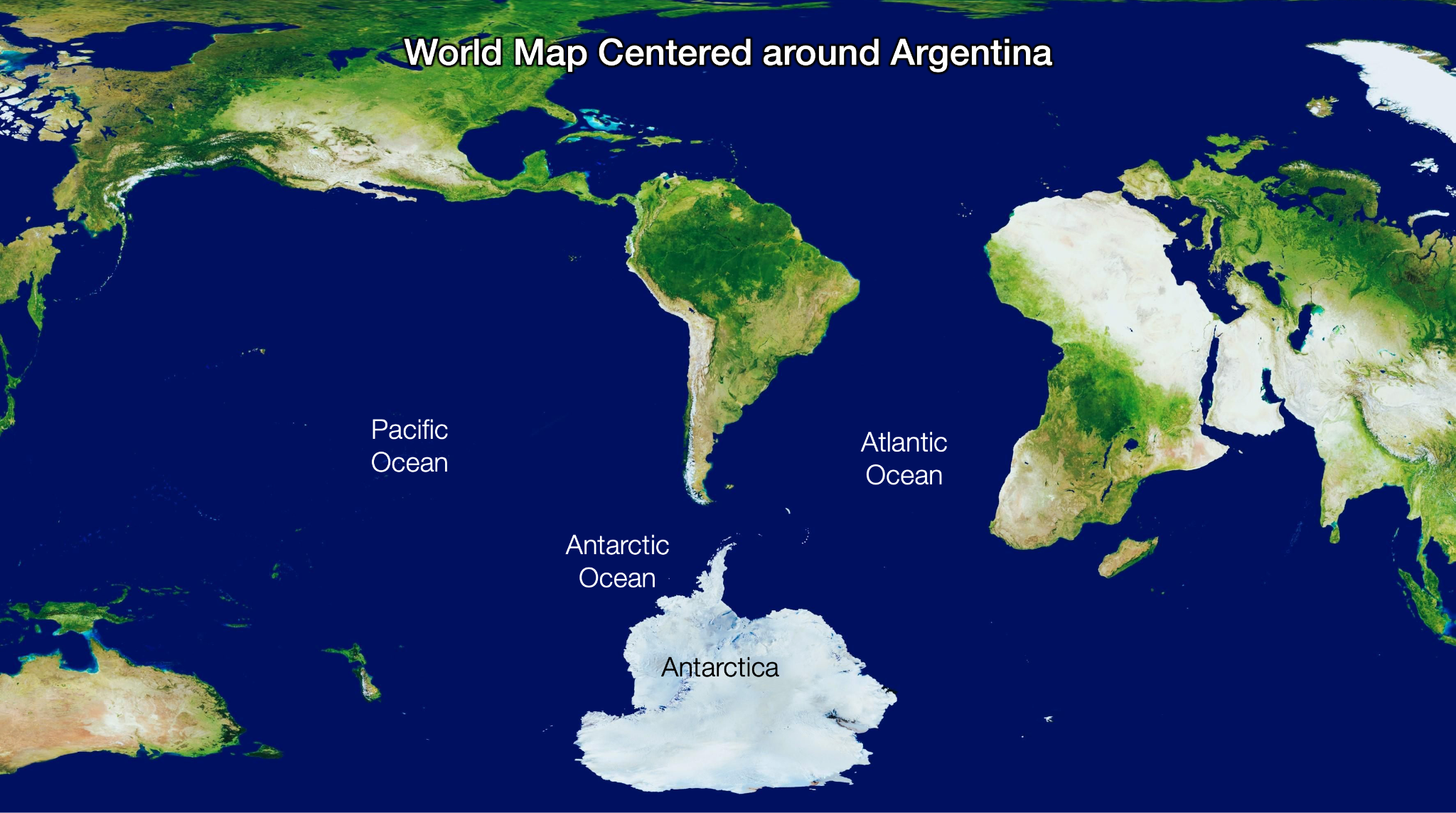
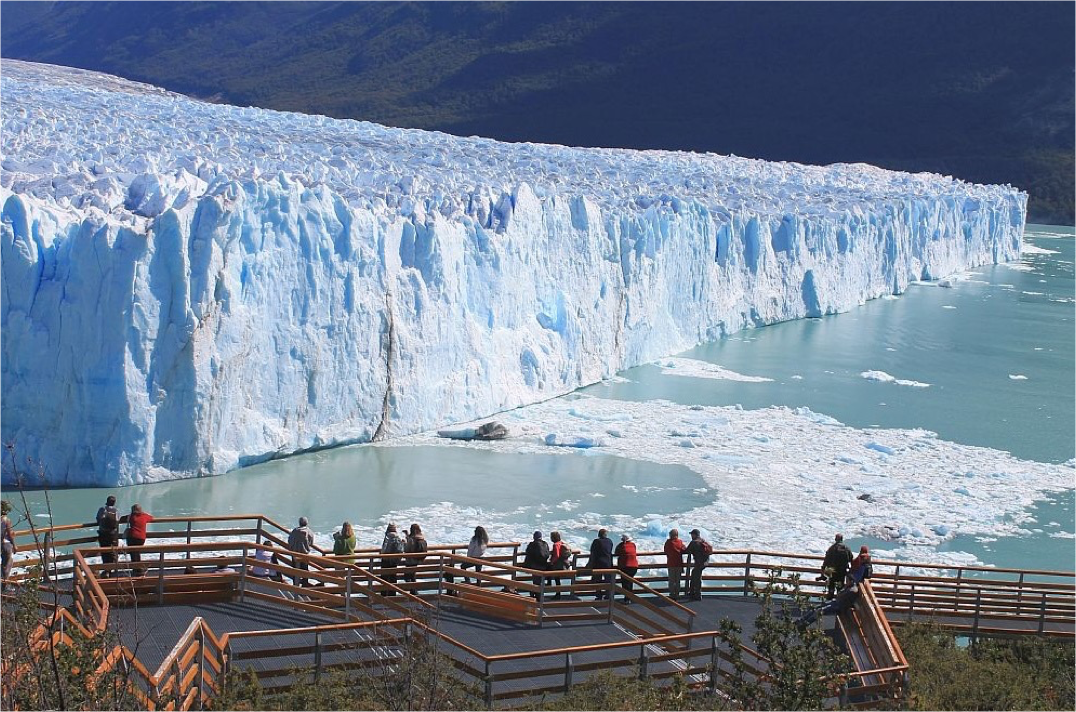
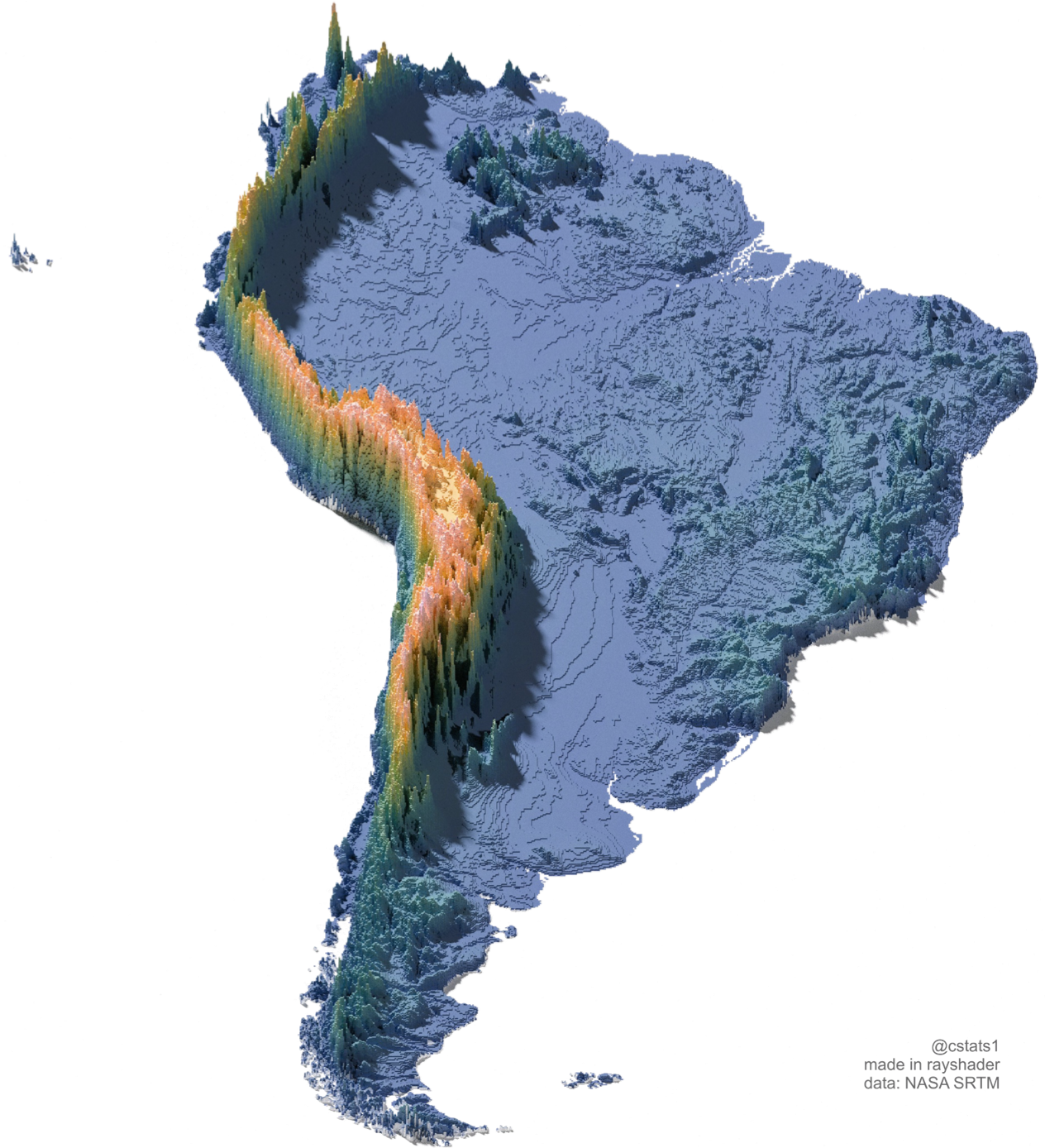
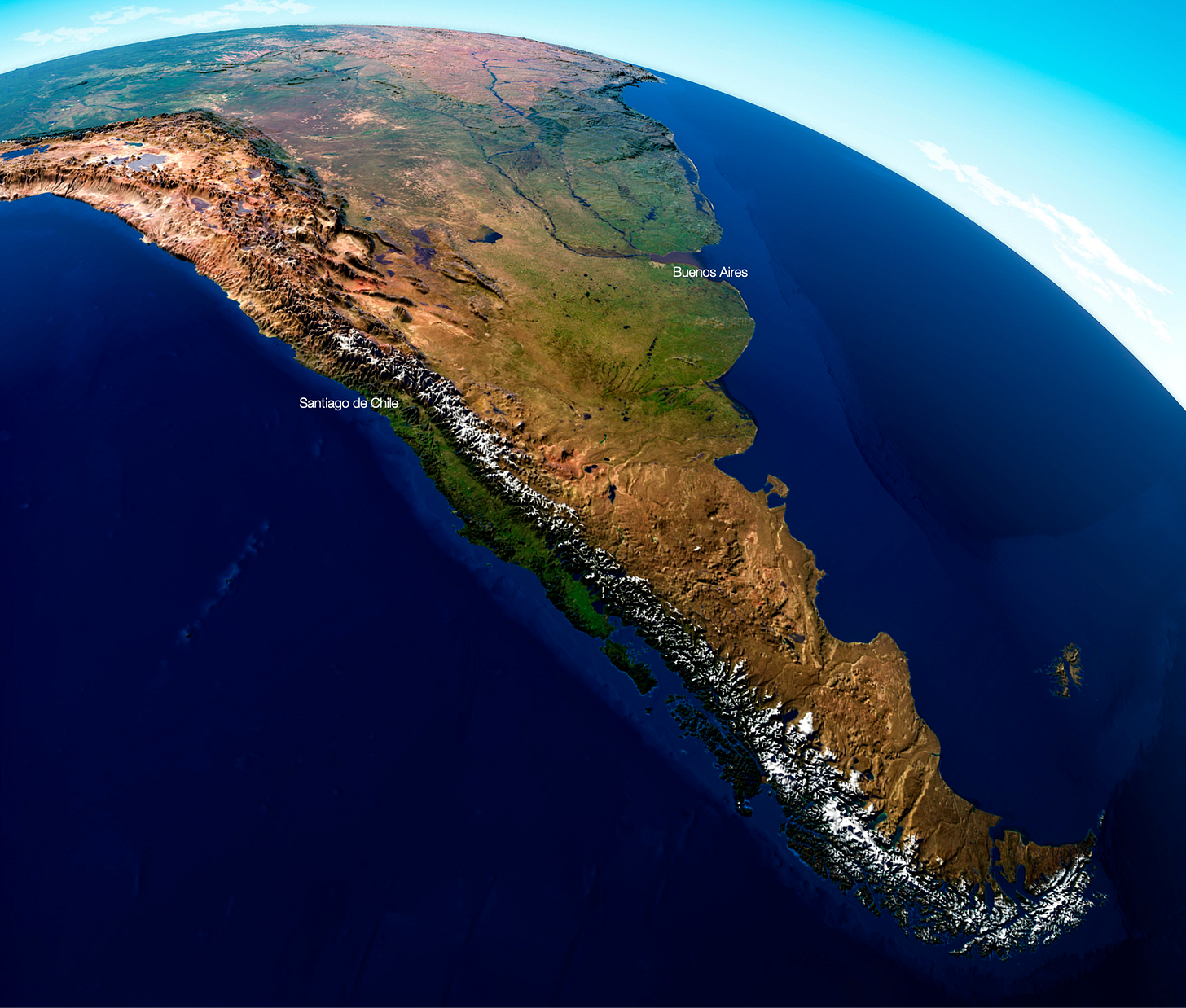
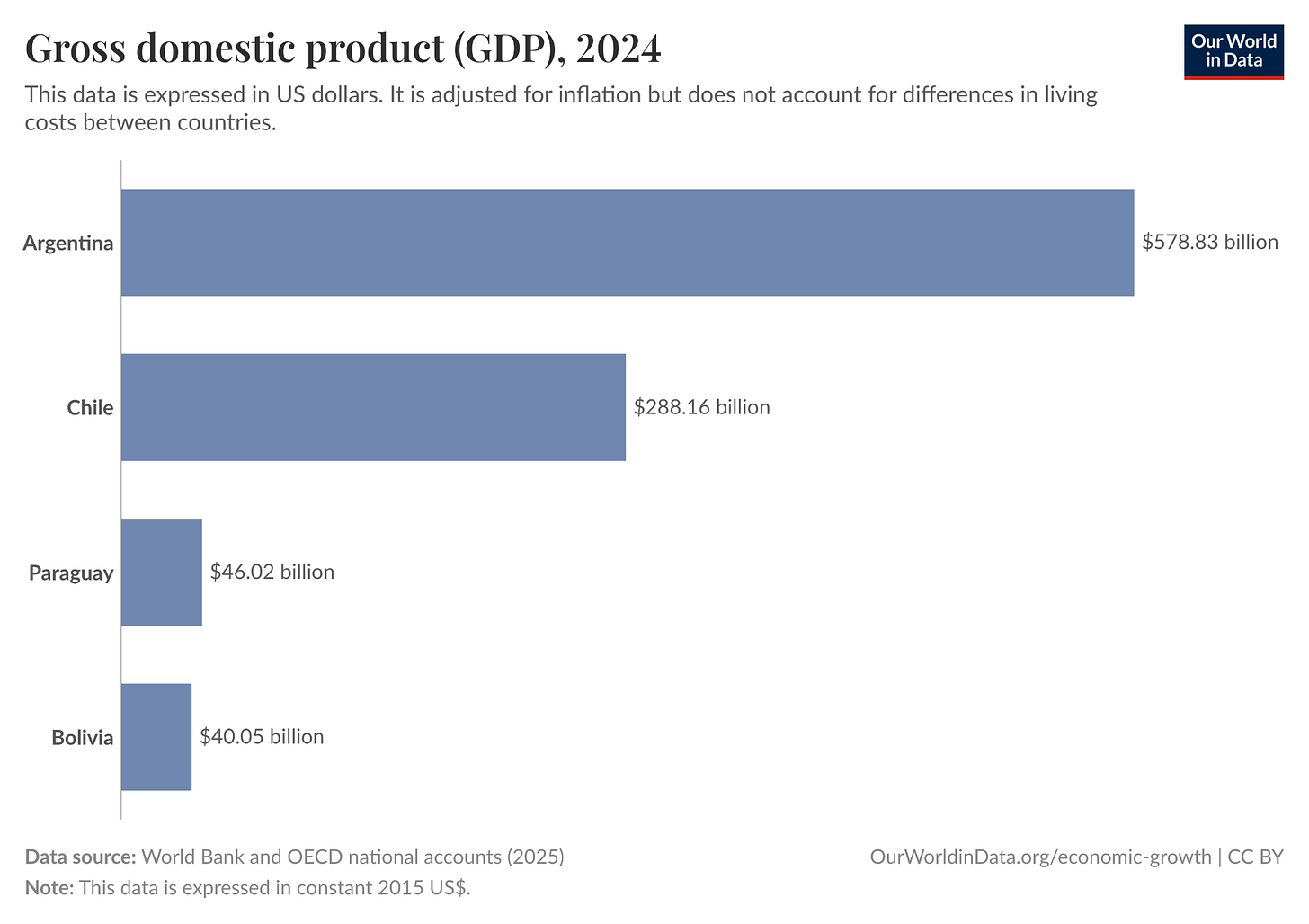
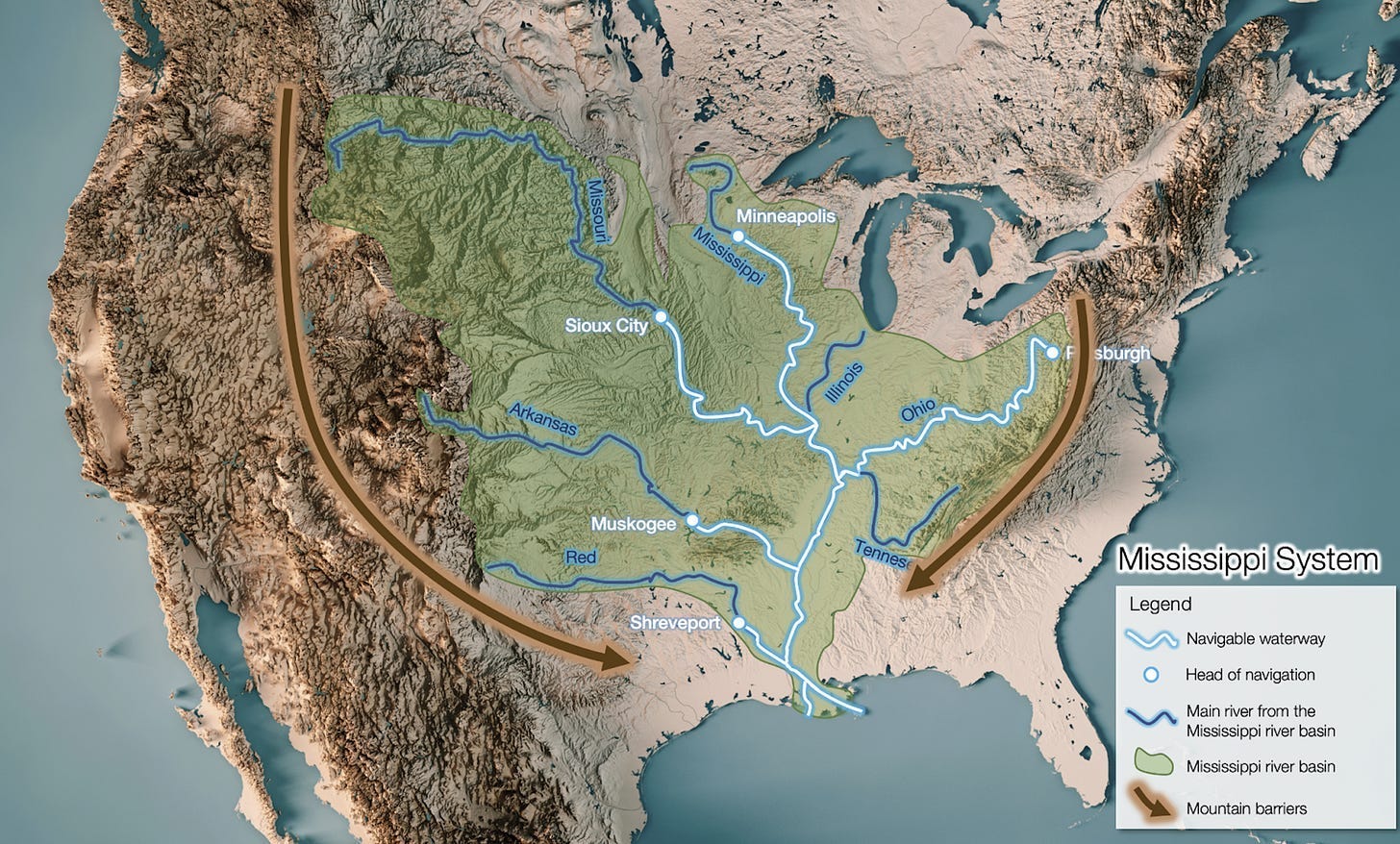
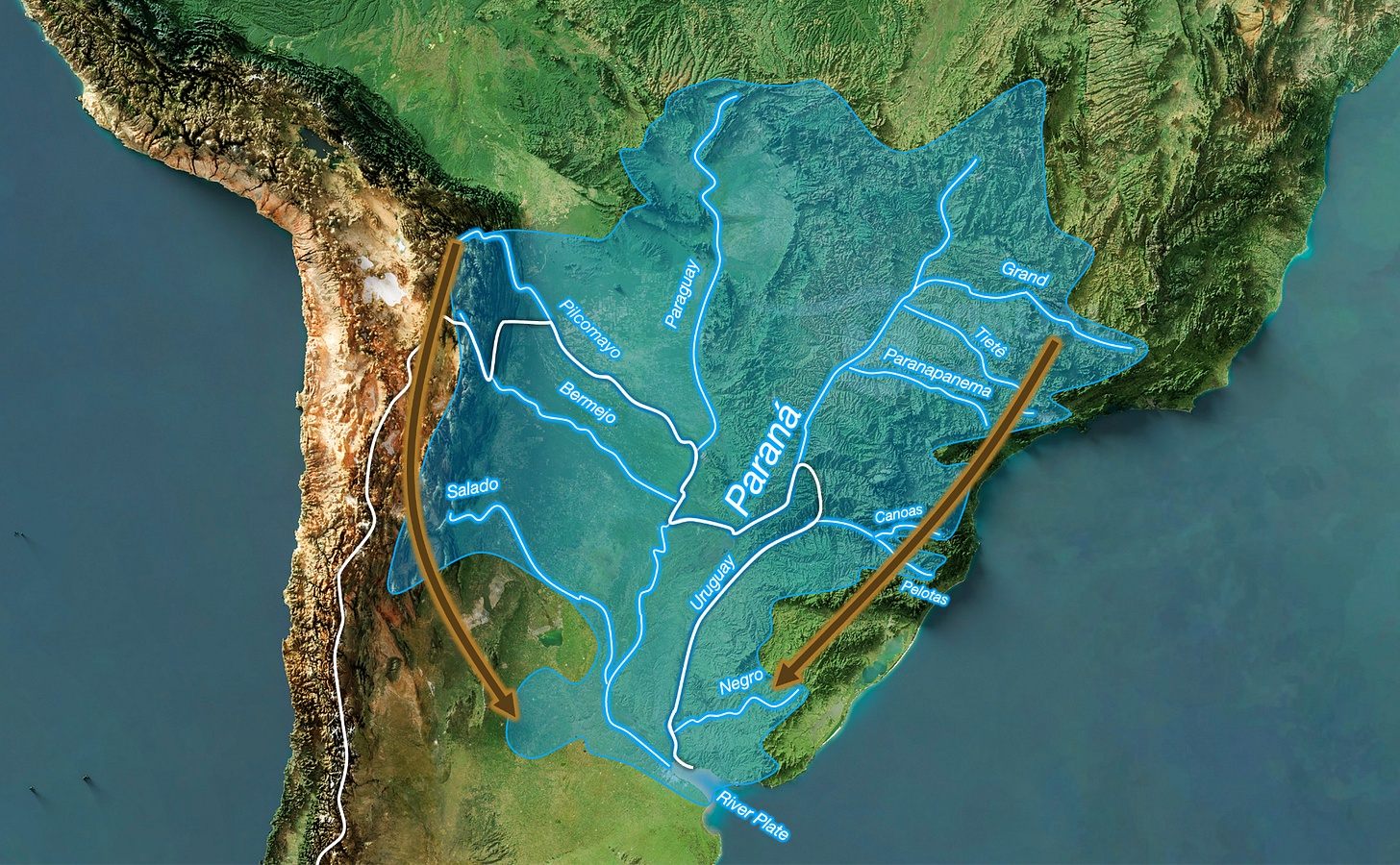
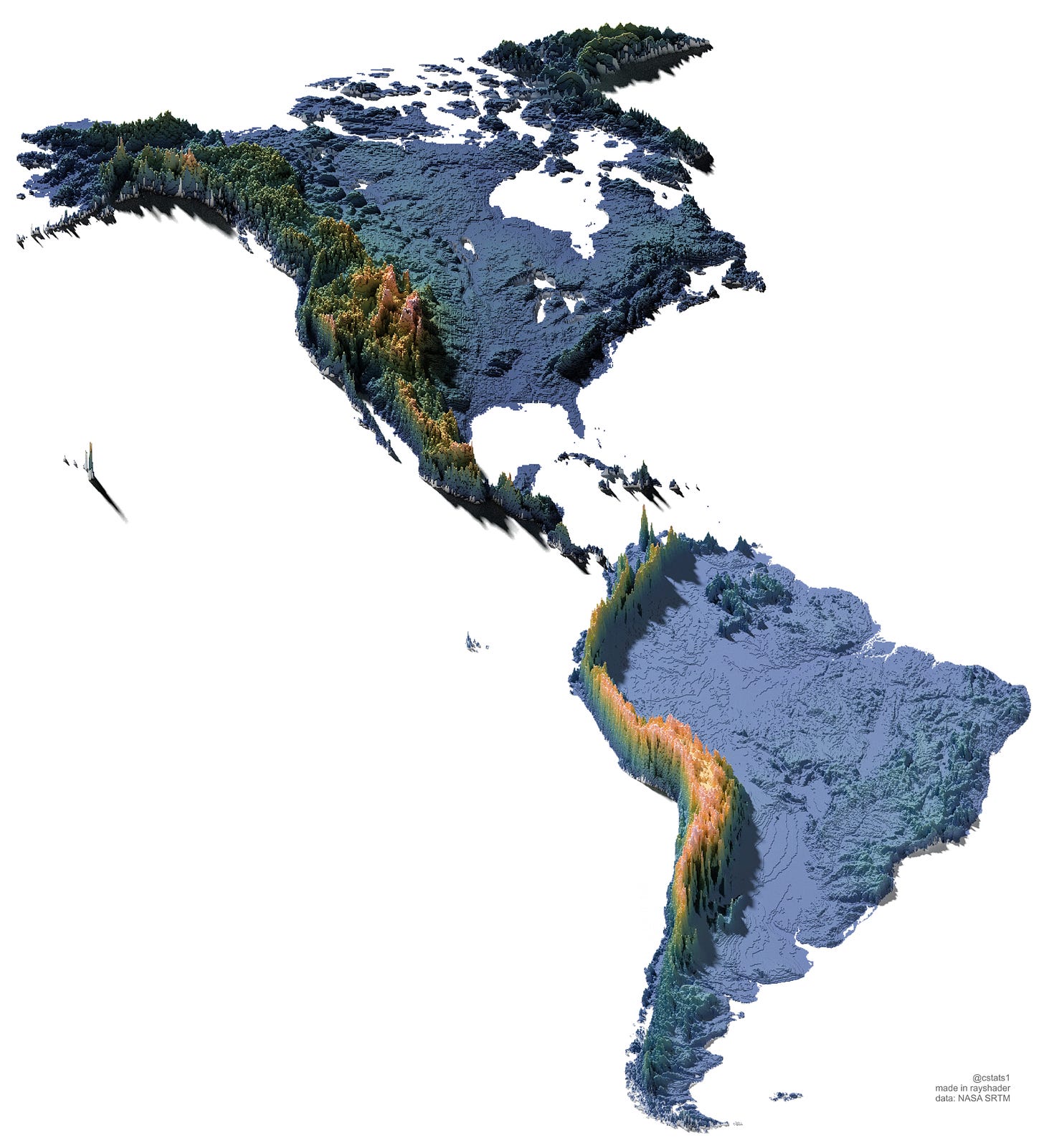
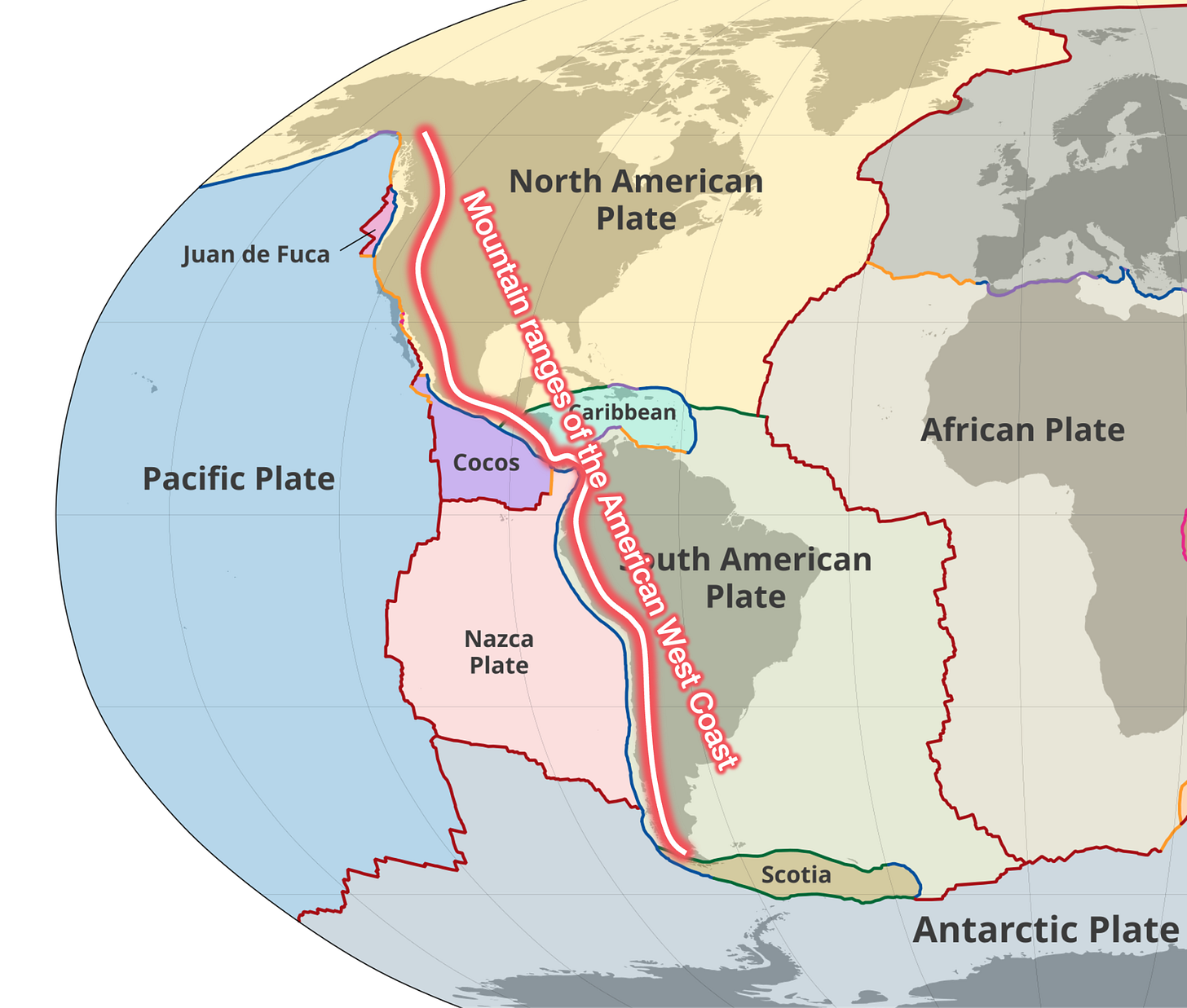
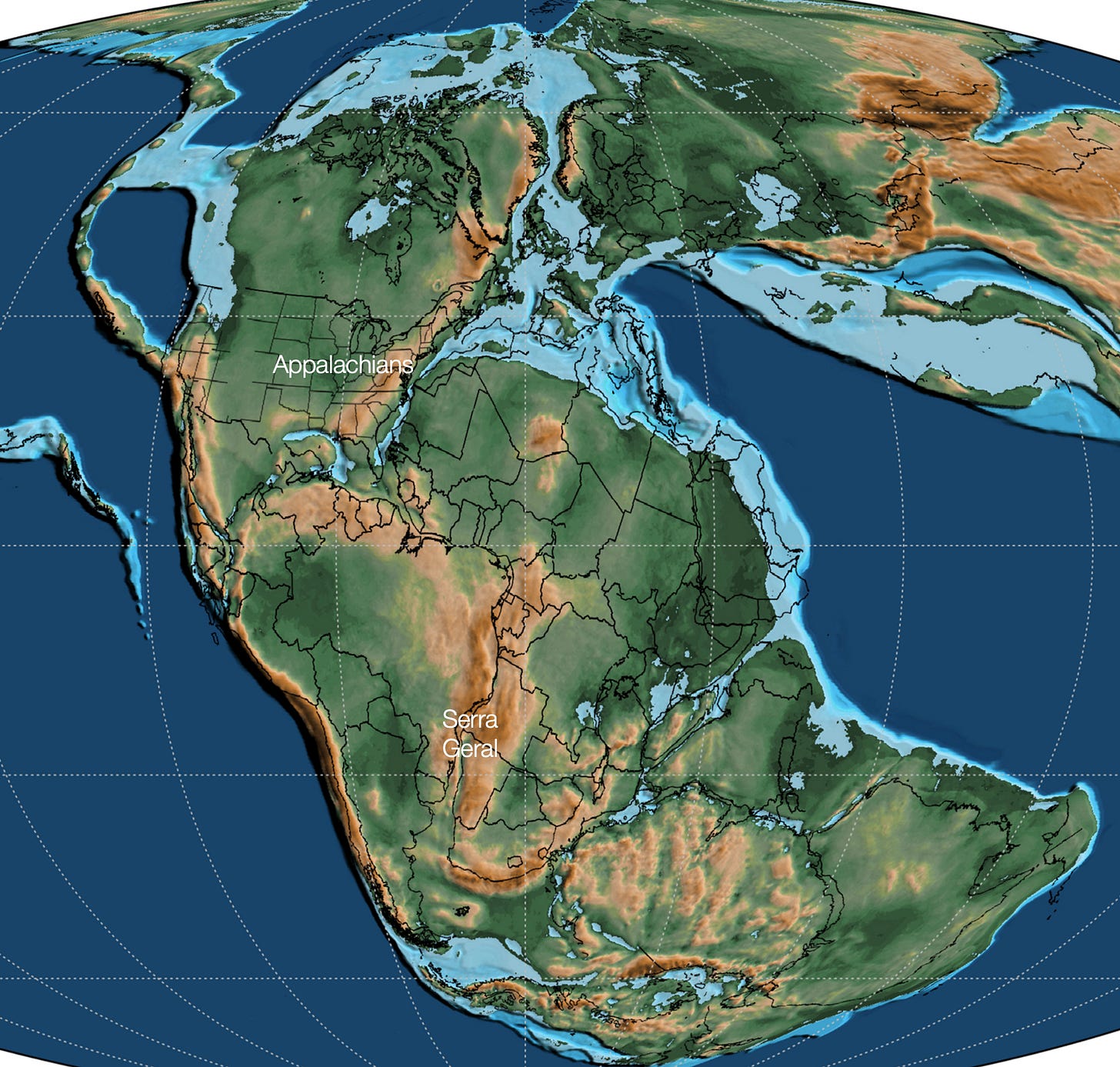
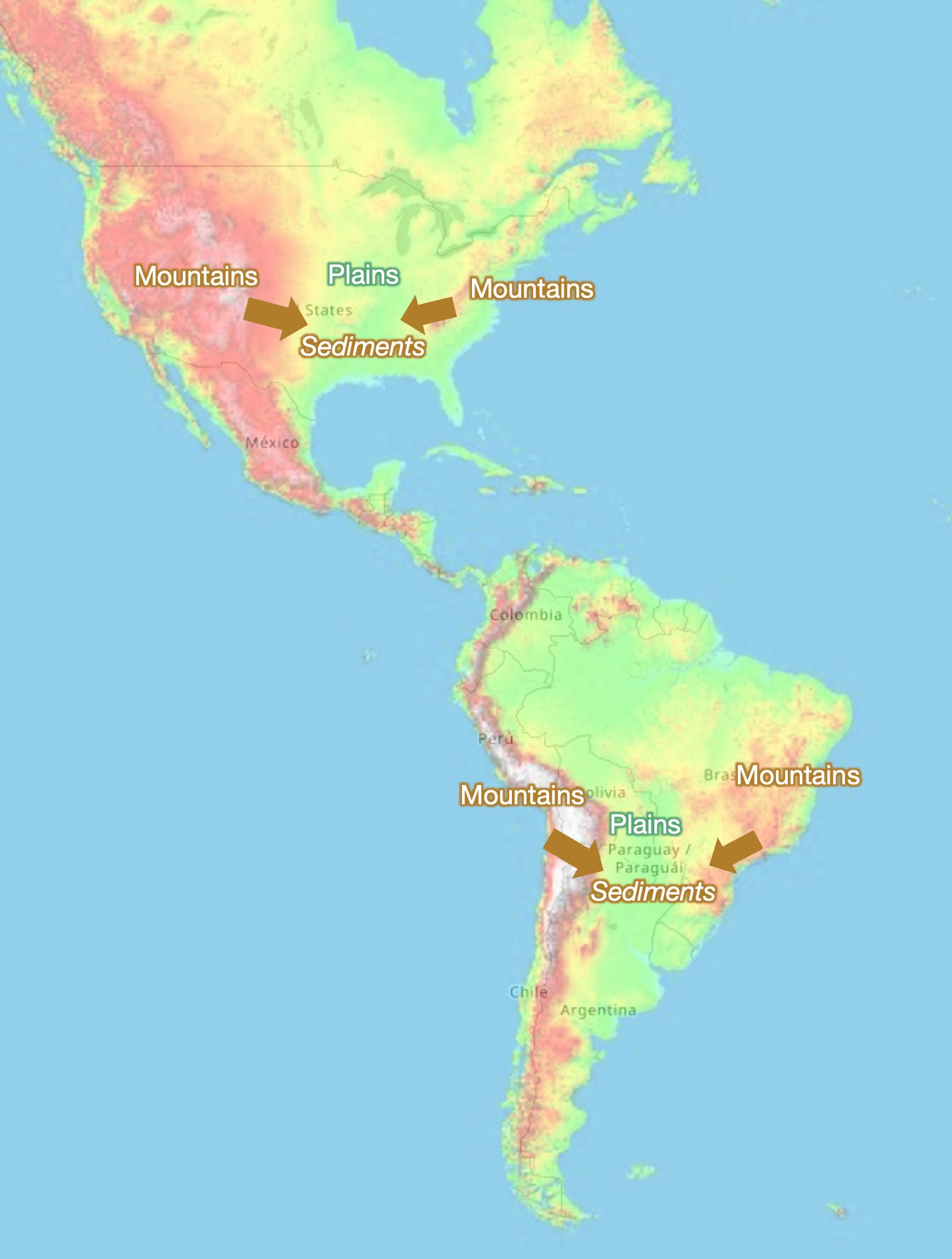
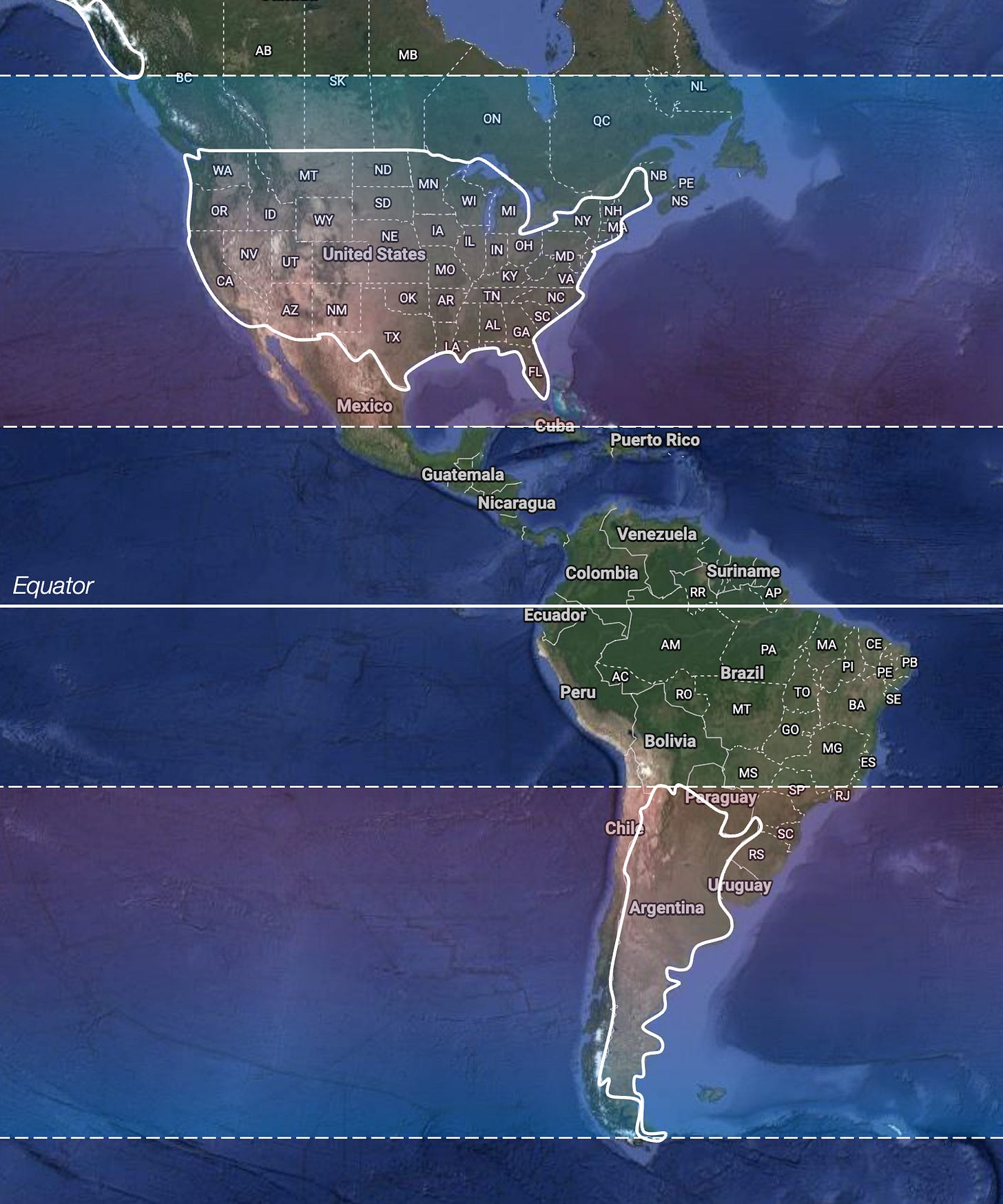
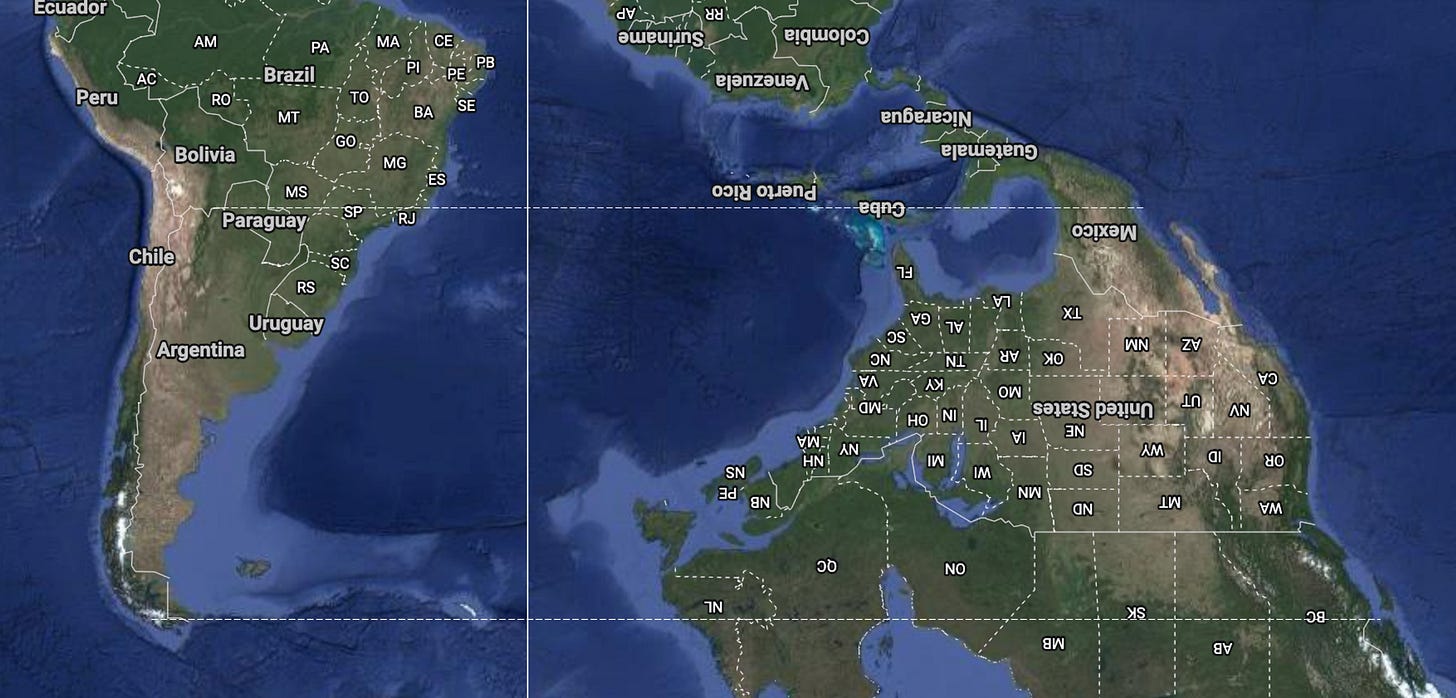
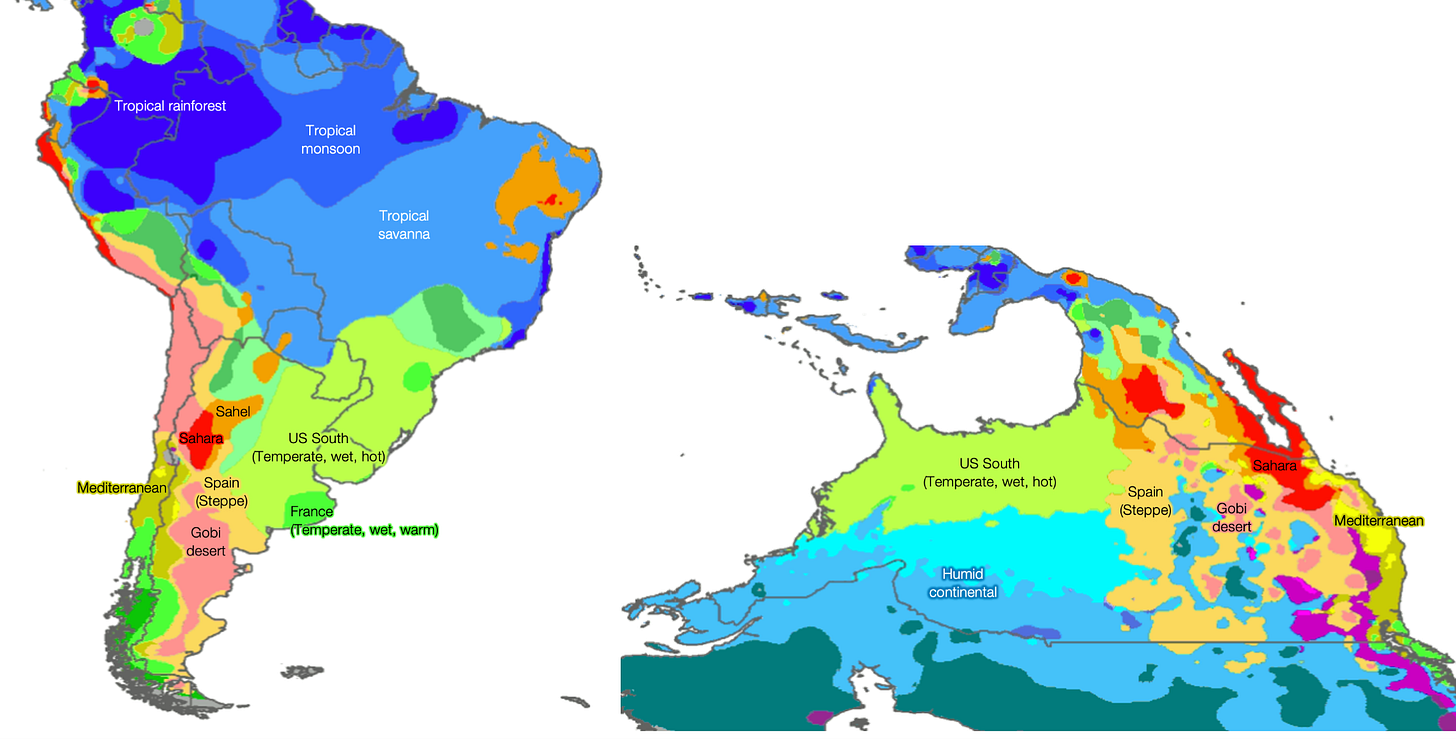
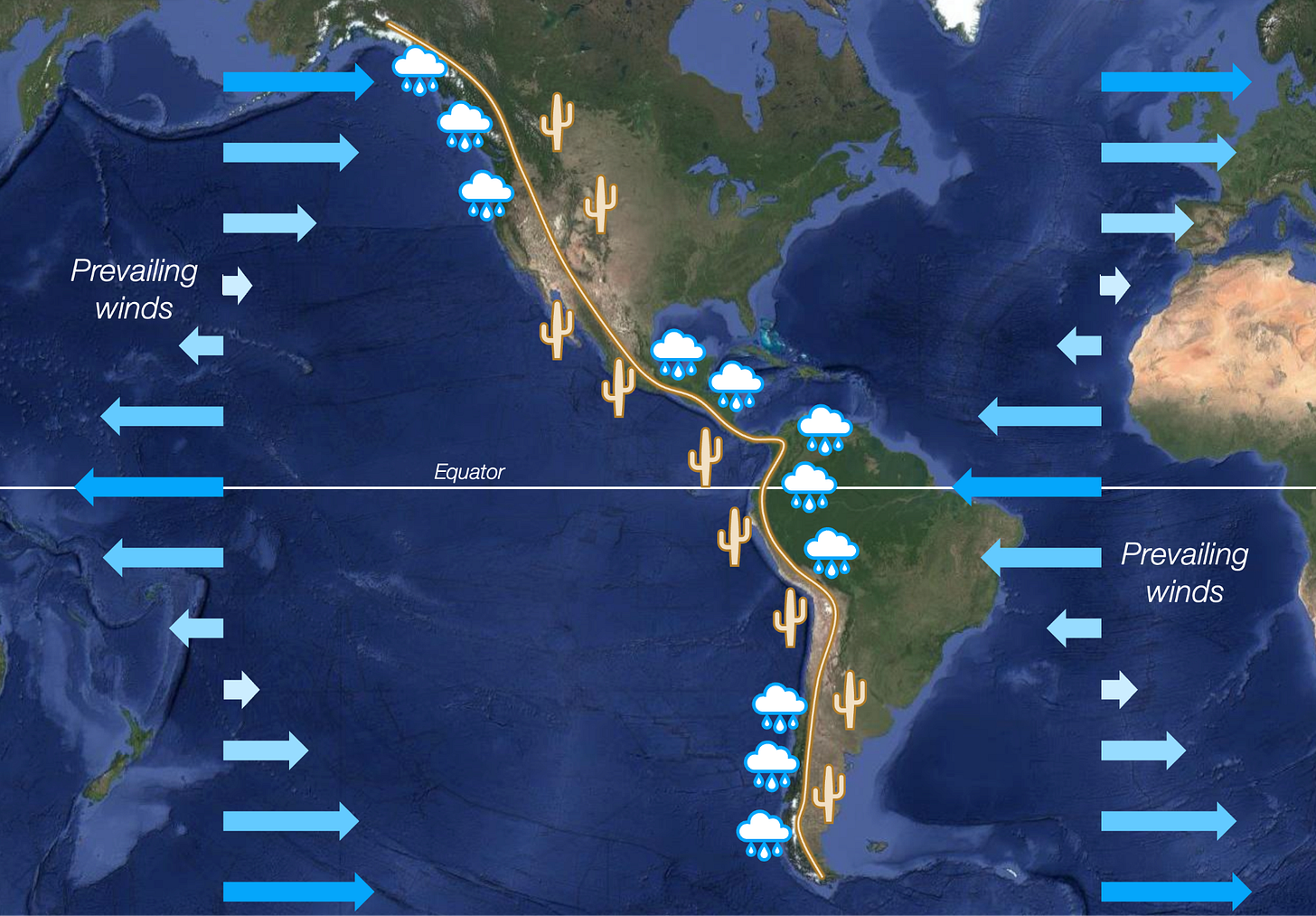
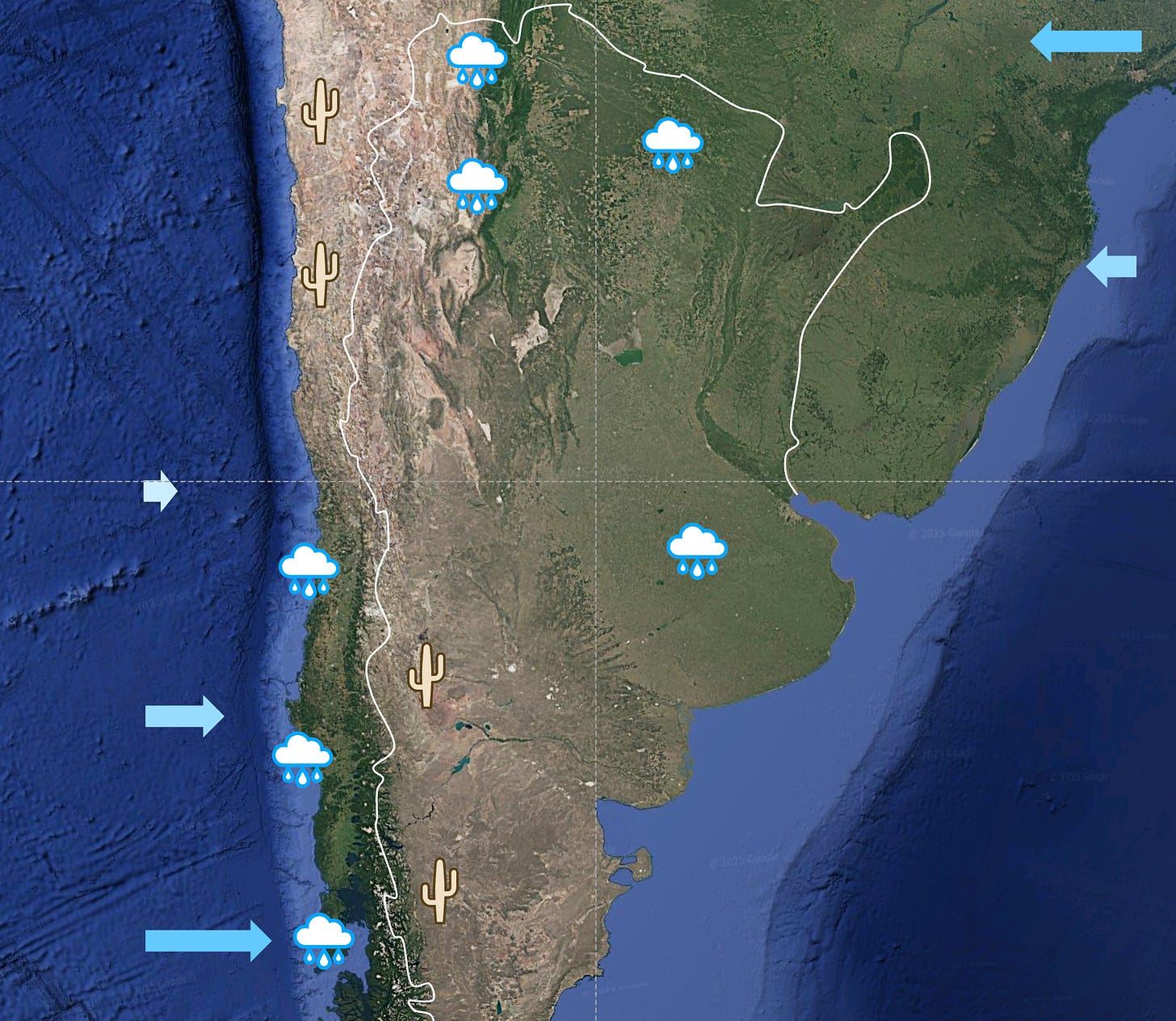
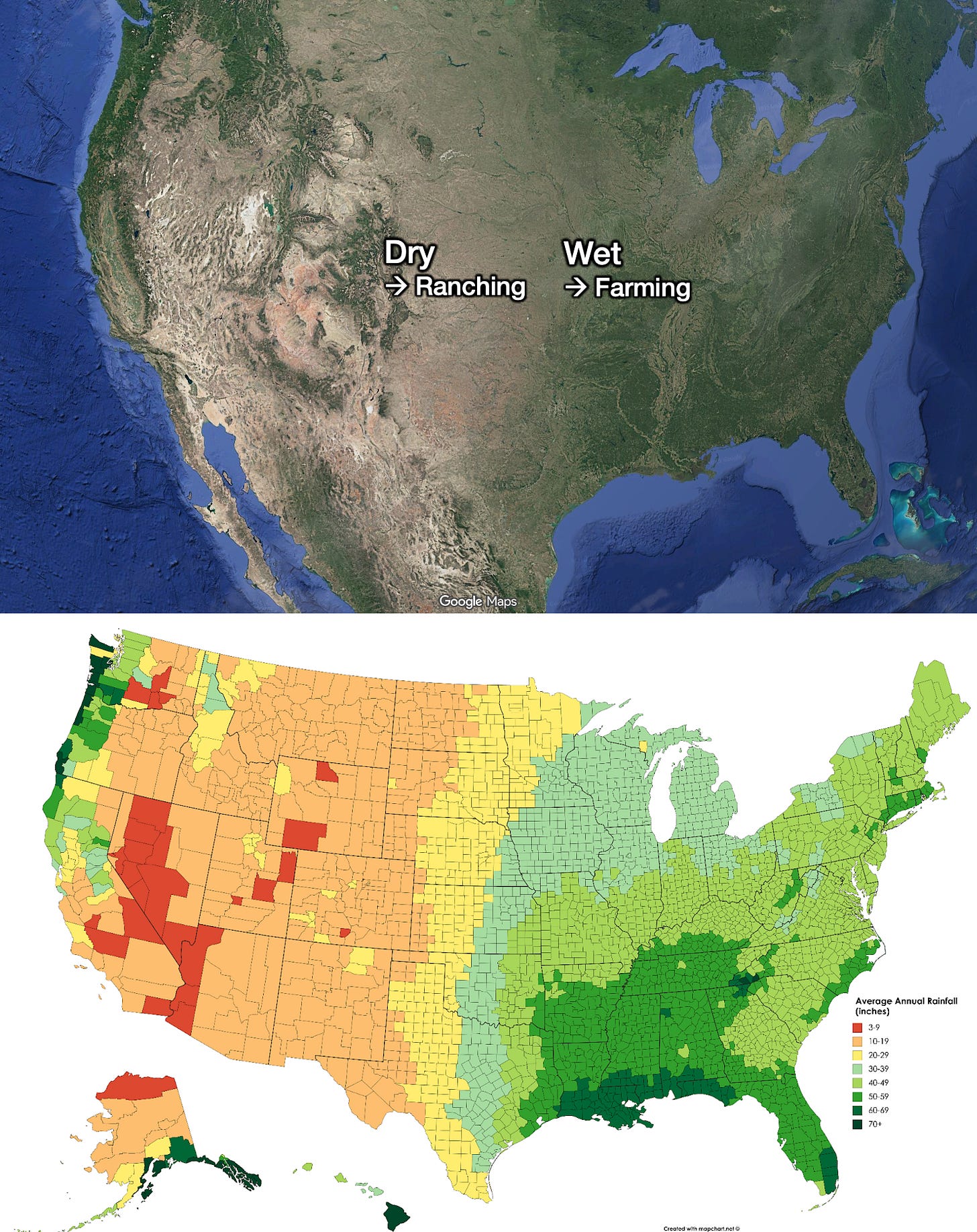
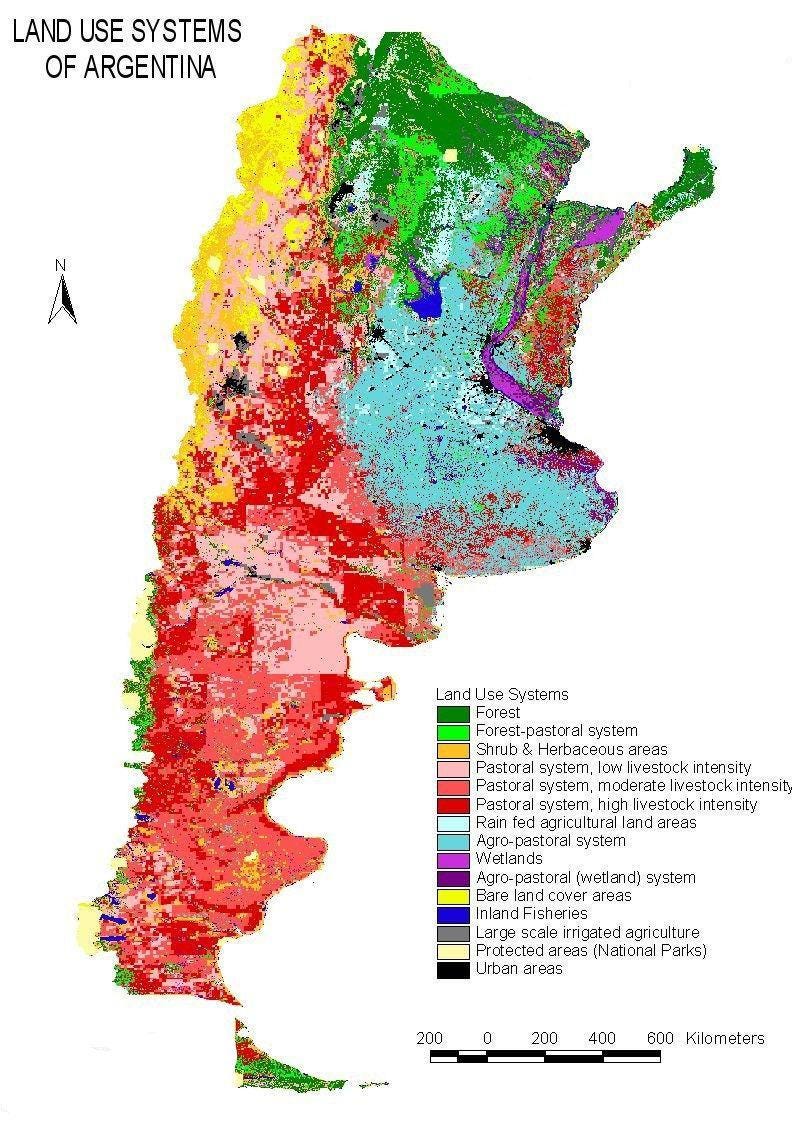

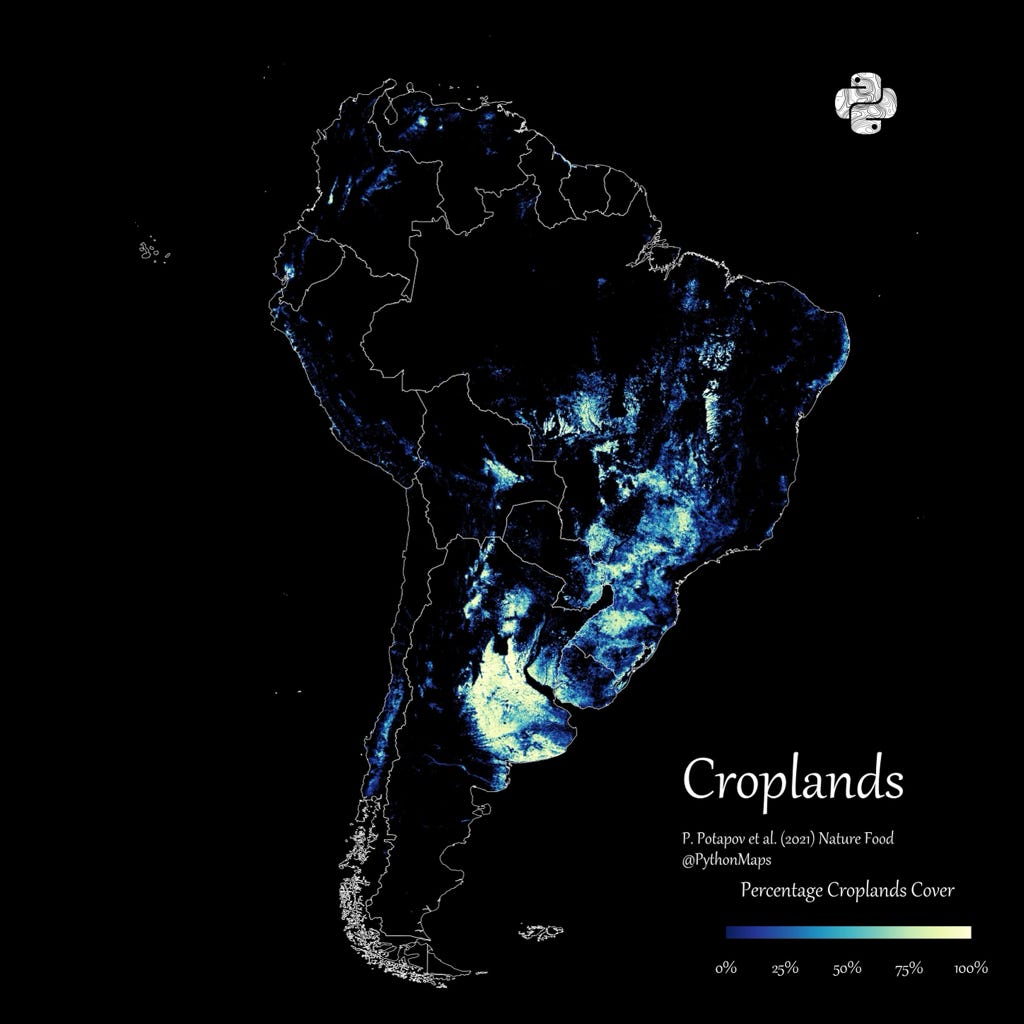
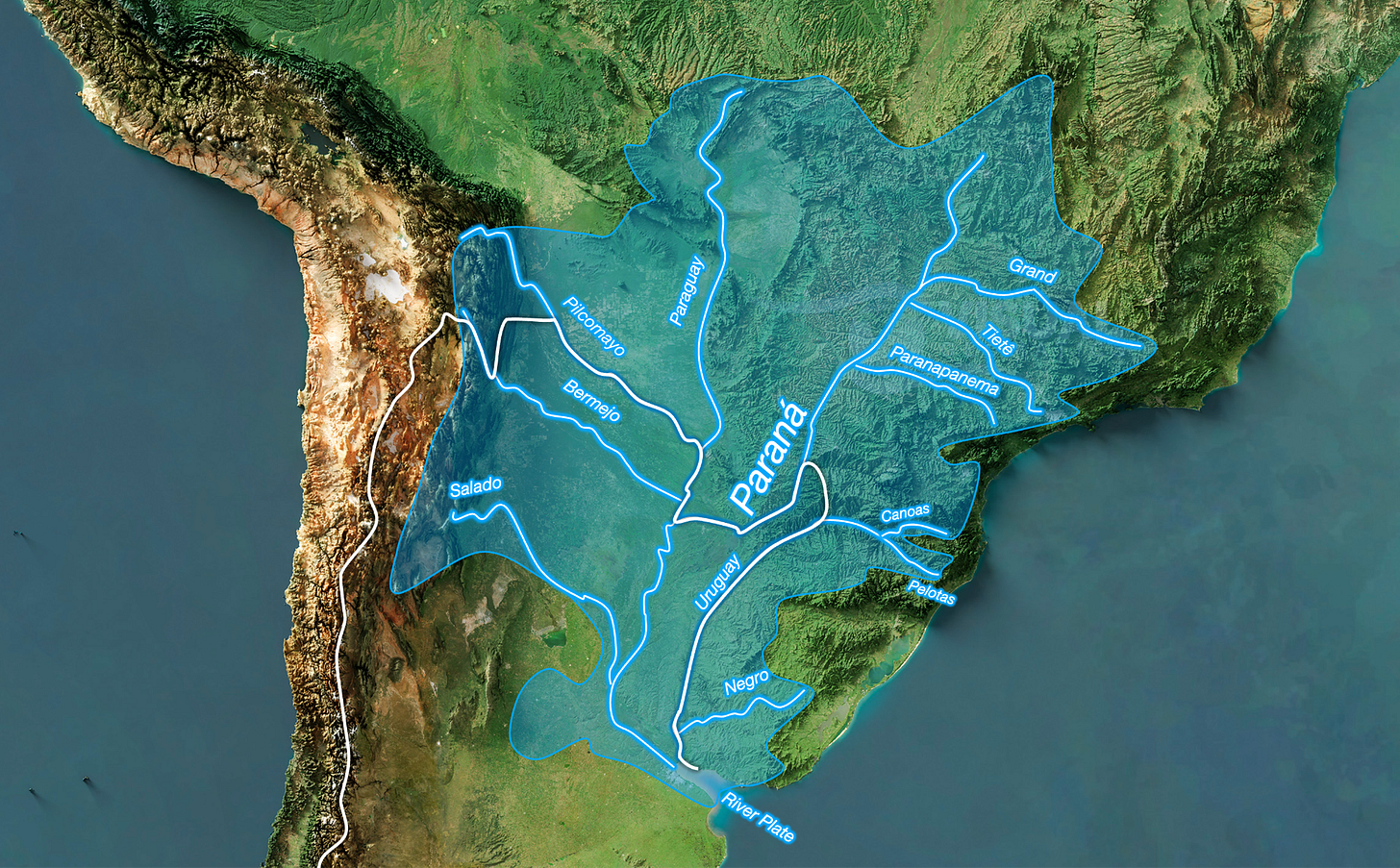
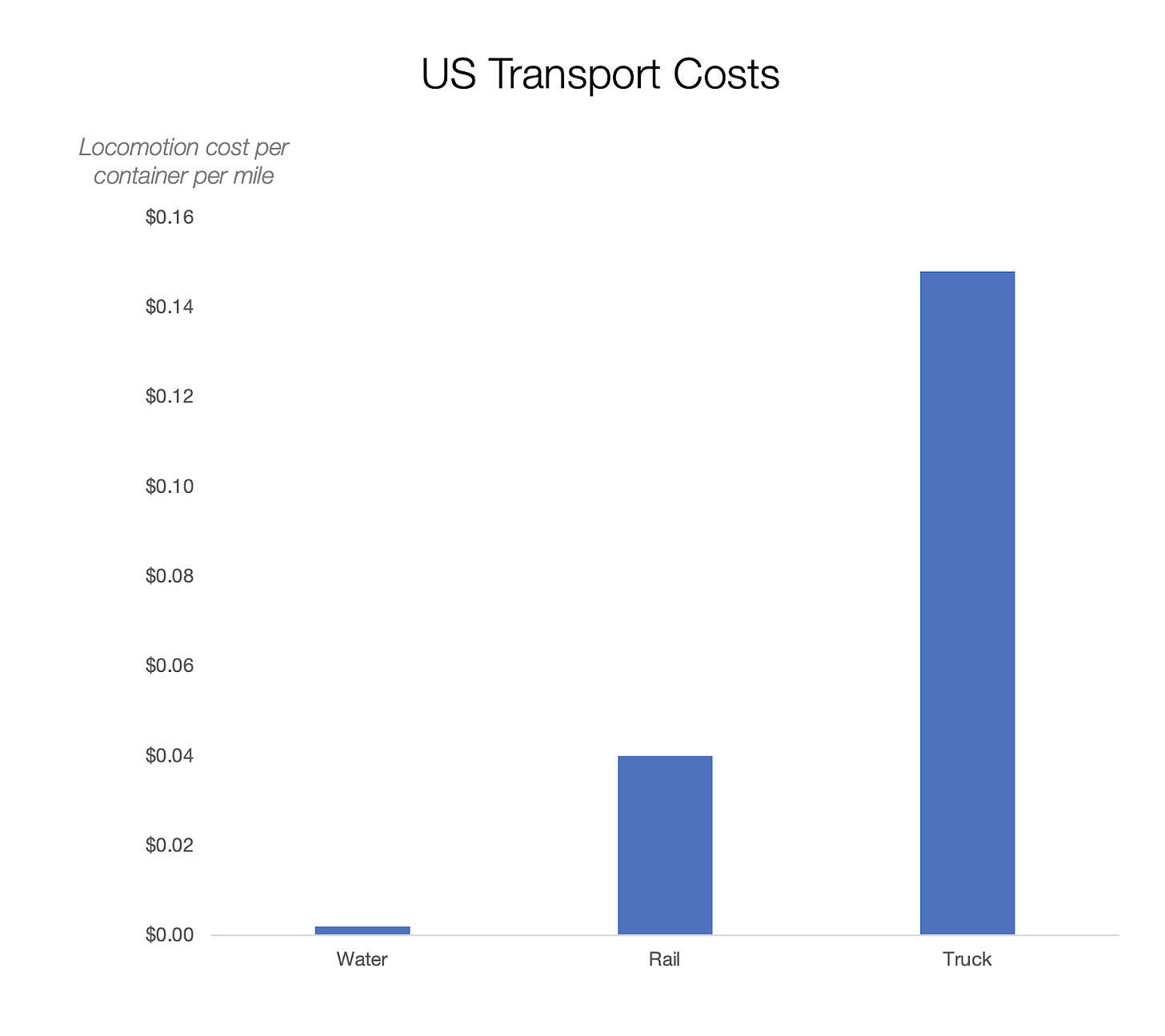
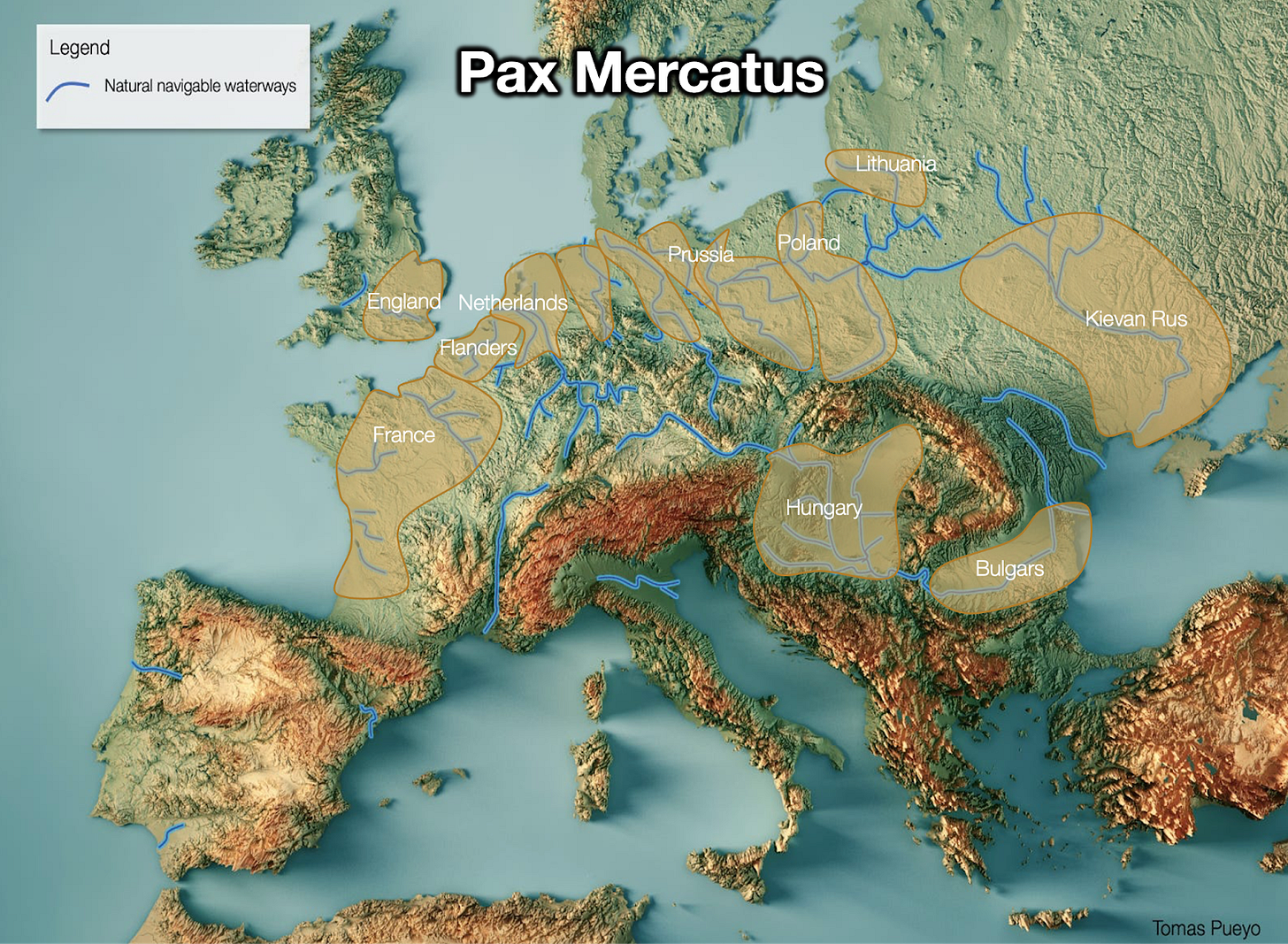
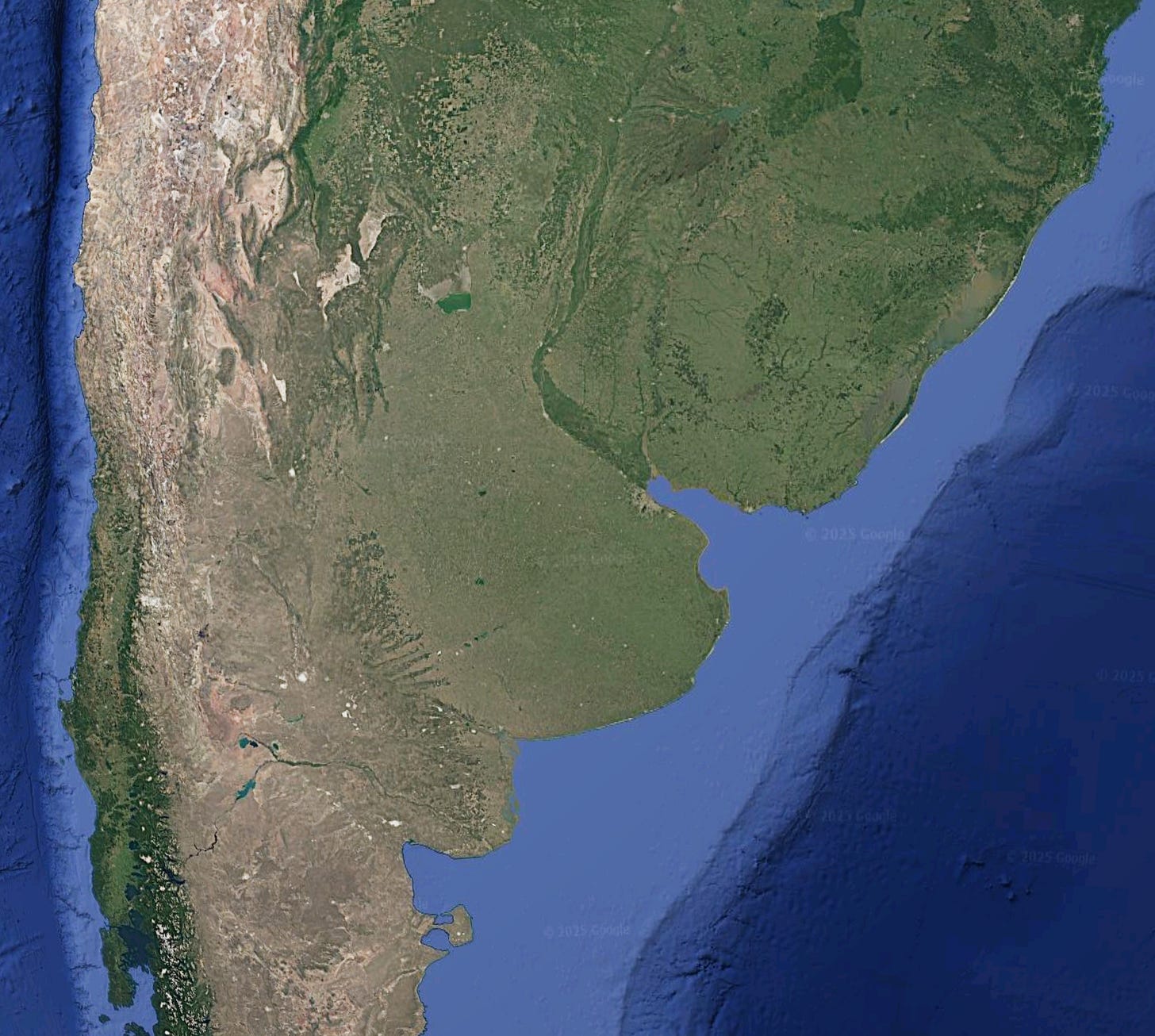
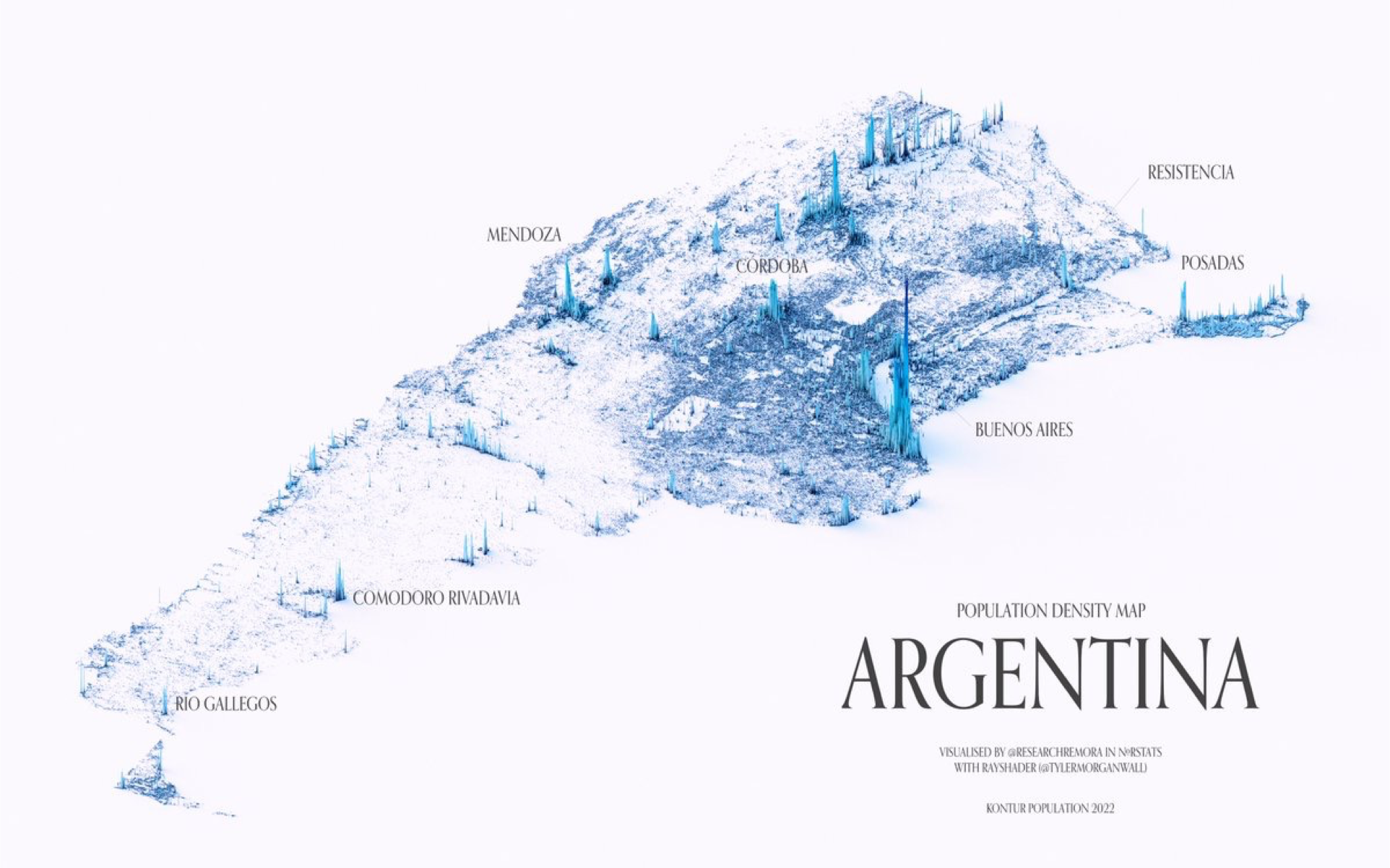
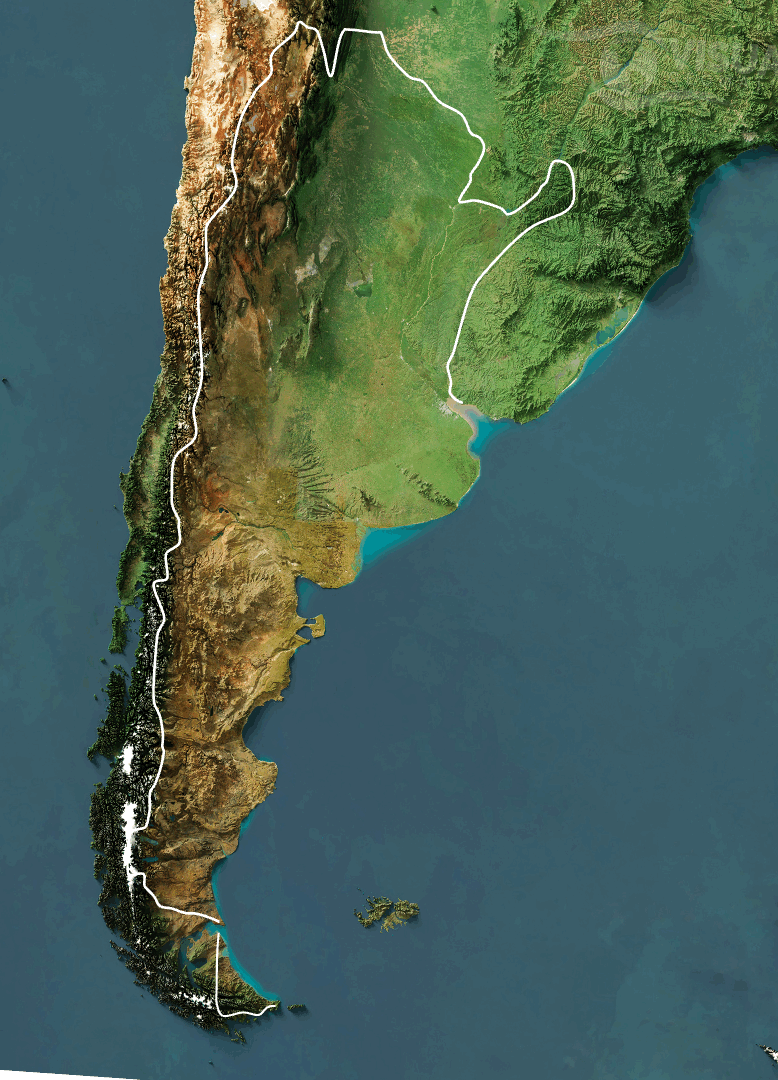
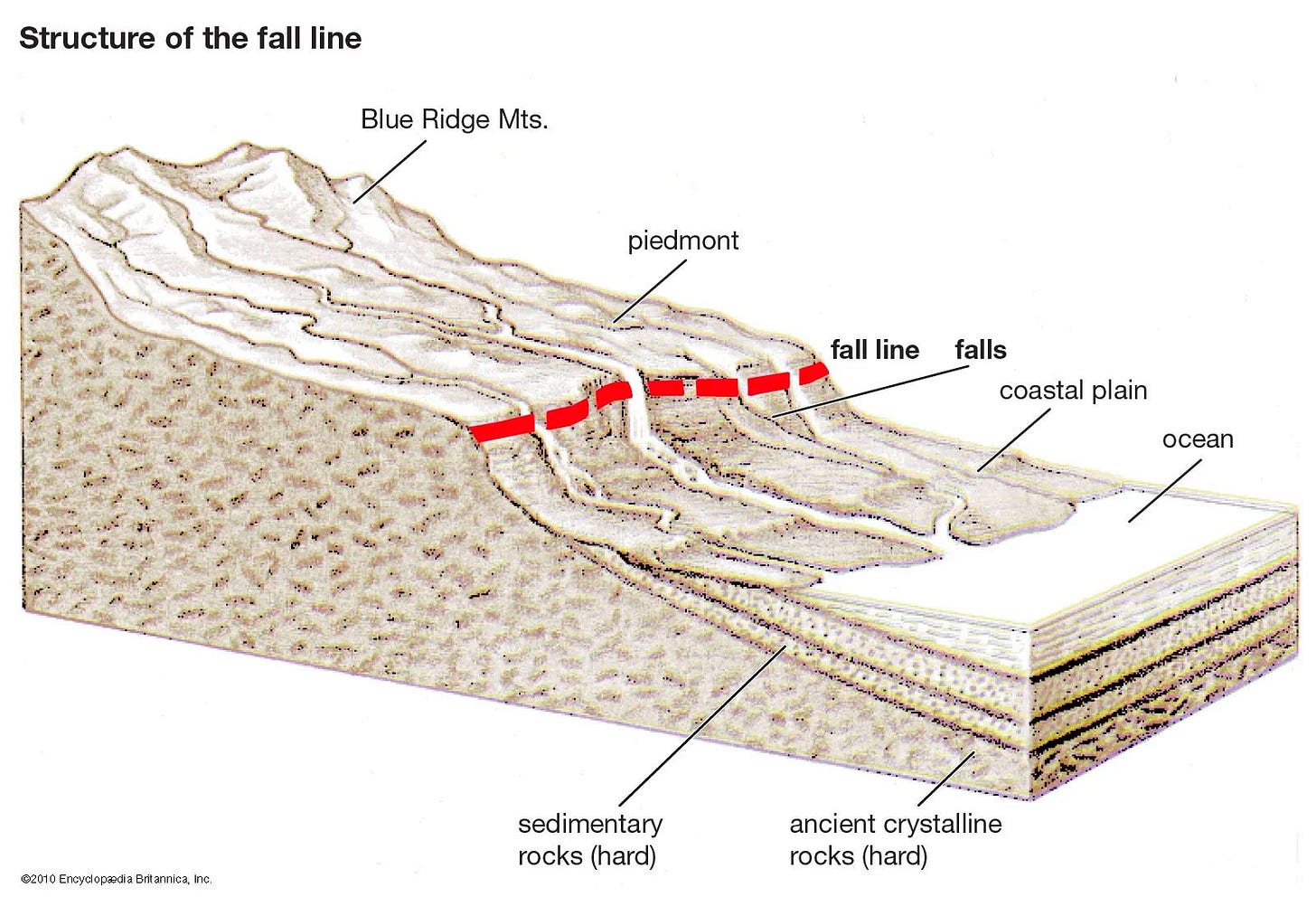
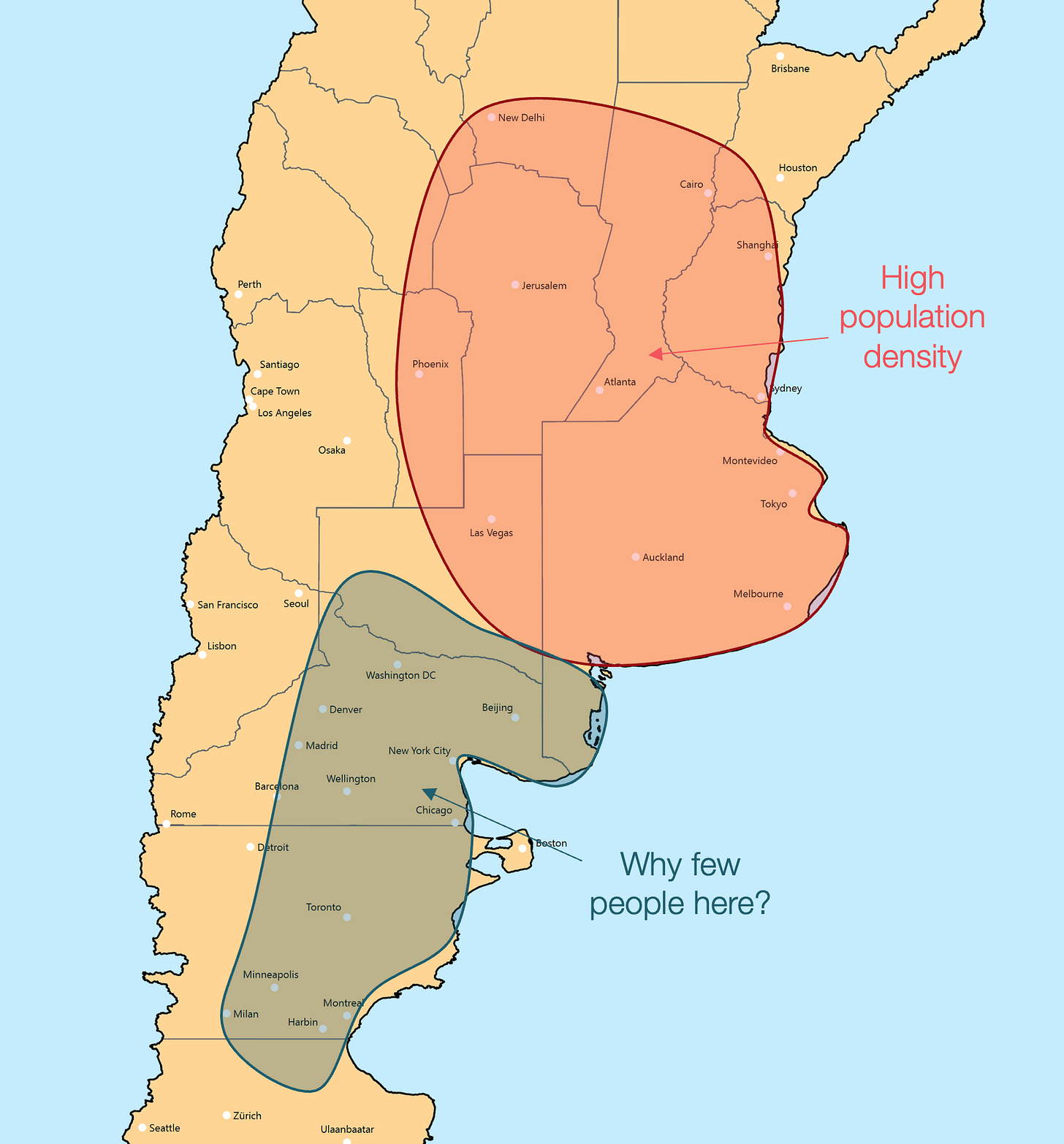
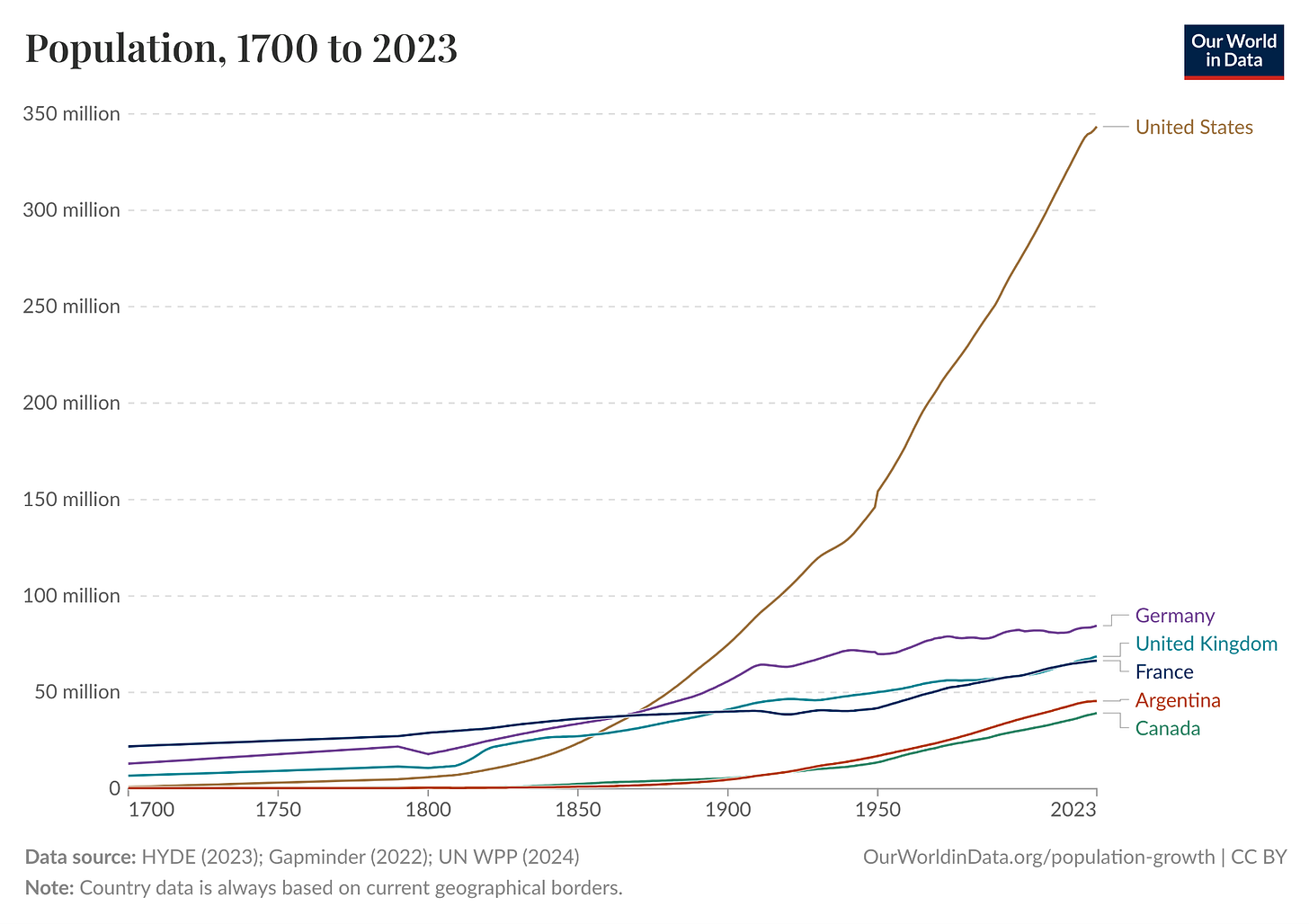
Very insightful, deep analysis, congratulations! As a Brazilian, this is the sad story about Latin America, a gifted land, with plenty of opportunities to be a world superpower (in some cases they even were), but ruined by bad policies, corruption, foreign influence during dictatorships and a fiscal irresponsability that seems to be eternal.
This is a cautionary tale for the U.S. A destructive political system like ours could certainly turn us into Argentina.
I’ve been there twice. It’s an amazing place! Wonderful culture. Terrible government.